SEO
SEO Copywriting: How to Write Content For People and Optimize For Google

If you want to build your blog audience, you’re going to have to get smarter with your content. The principal way to accomplish this is SEO copywriting.
Though SEO may sound complicated, it’s easier than you think; especially if you understand that writing for people, and not search engines, is a best practice.
To thrive, your online business must go beyond simply “writing content.” Your content needs to accomplish two goals:
- solve a particular problem
- appeal to the end-user (customers, clients, prospects, readers, etc.),
How do you create content that meets those goals? How do you create content that ranks well with Google and also persuades people? That’s what SEO copywriting is all about. Don’t worry if you can’t afford an expensive SEO copywriter. You can do it on your own following simple rules.
What Is SEO?
We all know what happens when you type a search query into a search engine and hit “enter”: You get a list of search results that are relevant to your search term.
Those results pages appear as a result of search engine optimization (SEO).
In a nutshell, SEO is a method of optimizing the effectiveness of your content for the search engines, in order to help it rank higher than content from other sites that target the same search terms.

Step by step, then, SEO is when:
- You research keywords …
- Then select a particular keyword and …
- Use that keyword to write content …
- Which other people then read and share on Twitter, Facebook, their own blogs and other social media platforms.
According to Redevolution, Google displays web pages in their search results based on the authority and relevance of the page to enhance the user experience. How does it measure authority and relevance?
- Google determines the relevance of your page by analyzing its content based on several factors, including where and how often you use certain words in that piece of content.
- Google measures authority by the number of links pointing to that page and how trustworthy those links are.
On the internet, links are like votes, with a slight difference. The winner of the election is determined solely by the number of votes, whereas your web page’s rank doesn’t depend so much on how many incoming links it has (quantity), but rather on the quality of those links. You and your marketing team need to understand this.
Quality has become the #1 ranking factor in Google, especially since the Google Panda and Penguin updates.
If you want more information on SEO, check out The Beginner’s Guide To SEO and The Advanced Guide To SEO.
Understanding Copywriting
Copywriting is the art and science of creating content that prompts the reader/end-user to either buy a product, subscribe to a list, take a test drive, or take some other action that will improve your.appeal to the end-user (customers, clients, prospects, readers, etc.),
Copywriting is salesmanship, says Bruce Bendinger. His definition of copywriting will make you smile:

Who drives a user to take action? A copywriter does. A copywriter is a skilled professional who writes copy for advertisements, promotions, and customer engagement. In the marketing world, they’re often referred to as “creatives.” An SEO copywriter tailors this to online content.
A copywriter is someone who understands people, knows what his audience likes and chooses the words that will appeal to them. The headline, words, phrases, sentences and paragraphs used in the content have to persuade and cause readers to take a specific action. An SEO copywriter also understand how Google feels about certain words and phrases, especially long tail phrases.
If you’re a blogger, freelance writer, or online business entrepreneur, you can become a sought-after copywriter when you develop your creativity and perfect your writing skills.
If you want to build a thriving online business and survive in the everchanging world of SEO, your job is to create useful content that’s interesting, persuasive, and well-optimized for search engines; and you have to do it consistently. That is part of the user experience, getting new fresh content on demand.

What is SEO Copywriting?
SEO copywriting has evolved, since Google started rolling out their updates.
If you want to create highly useful content that ranks well in Google and simultaneously funnels paying clients or customers to your online business, you must think about the components of Google’s Ranking Algorithm.
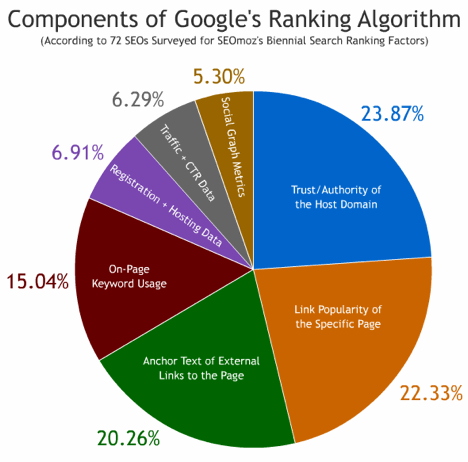
SEO copywriting is all about creating useful, compelling, and valuable content that targets specific keywords so that other people will gladly promote it on social media platforms.
This increases the authority and relevance of your content and improves its ranking in Google for the selected keywords. So when you highly recommend something, Google sees it relevant and you will achieve greater SEO content results.
SEO copywriting helps you target your customers and solve their specific problems with well-crafted content.

Six Elements of SEO Copywriting
Certain elements of valuable content, such as visual appeal and timeliness, are the hallmarks of copywriting grace.
Implementing SEO best practices consistently throughout your content will naturally push your content to the Google top 10 and increase your traffic.
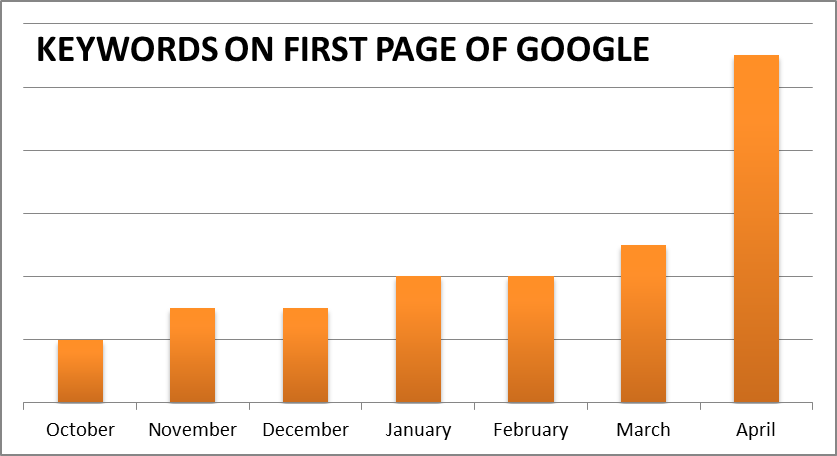
However, there are elements that will always enable you to rank highly in Google, as well as increase your conversion rate. Before you implement the elements of SEO copywriting, remember that there are things that should come before on-page optimization.
Here are the 6 elements of SEO copywriting that matter:
1) Site Speed
A study by Akamai revealed these stats:
- 40% of people will abandon a web page if it takes more than 3 seconds to fully load.
- 47% of end users expect a web page to load in two seconds or less.
Site speed has been a ranking factor since 2010 and it’s good for users, too. If your load time is more than 2 seconds, which is the standard load time for sites, then you should take steps to improve it.
That’s because if your content is useful and interesting, but it takes a long time for your page to load fully, your visitors will leave, because their attention span is short. They leave because of a bad user experience.
How do you measure your site load time? Follow these basic steps — I’ll use Psychology Today as an example:
Step one: Use Pingdom’s website speed test.
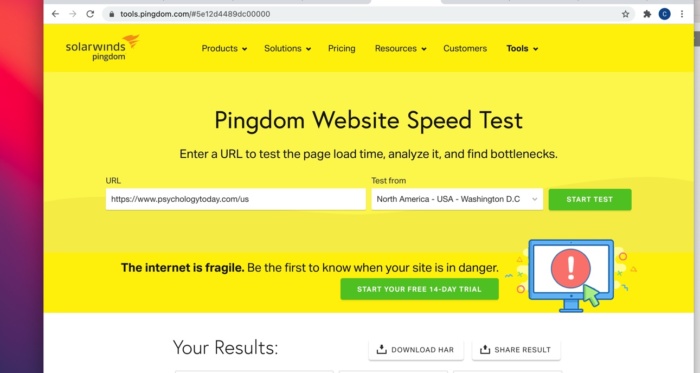
Step two: Analyze your site speed.

You see that Psychology Today is fast. The load time is 770 milliseconds, beating the standard load time by 0.03 seconds.
Step three: Check the history. You want to determine the previous load times for your site.
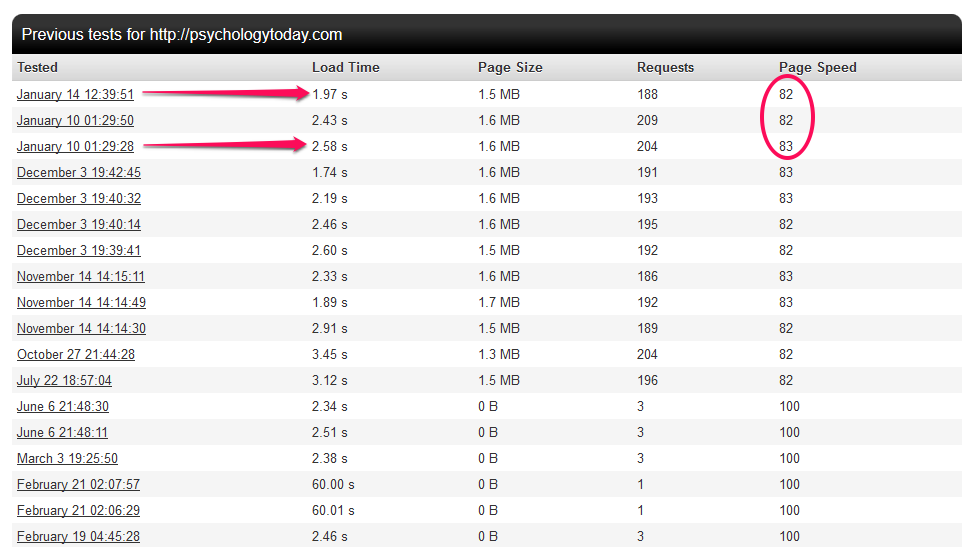
In our example, the history shows that Psychology Toda≥≤≤÷y had a load time of 2.58 seconds on January 10, 2015. The page size was 1.6 MB at the time. Today, the page size has been reduced to 1.5 MB and the load time improved to 770 milliseconds. This is what SEO firms check first and so should you.
Go ahead and check your site load time using Pingdom.
If you want to improve your site speed, read these step-by-step guides:
Does site speed lead to improved conversion rates? Yes it does.
This case study reveals how Smashing Magazine experienced an impressive boost in their conversion rate when they cleared their database of all of the clutter that old plugins had created, then merged all of the databases into one.

2) Headline
Your content may be valuable, but if your headline is mediocre, your click-through rate will be low. Don’t waste valuable SEO copy.
On the average, five times as many people read the headline as read the body copy. When you have written your headline, you have spent eighty cents out of your dollar. —David Ogilvy
For the most success, bloggers should spend about six hours per post. Tasks that should be performed in those six hours include creating content, monitoring social signals and consumer reactions, tracking analysis, etc.
How much time do you spend crafting the perfect headline?
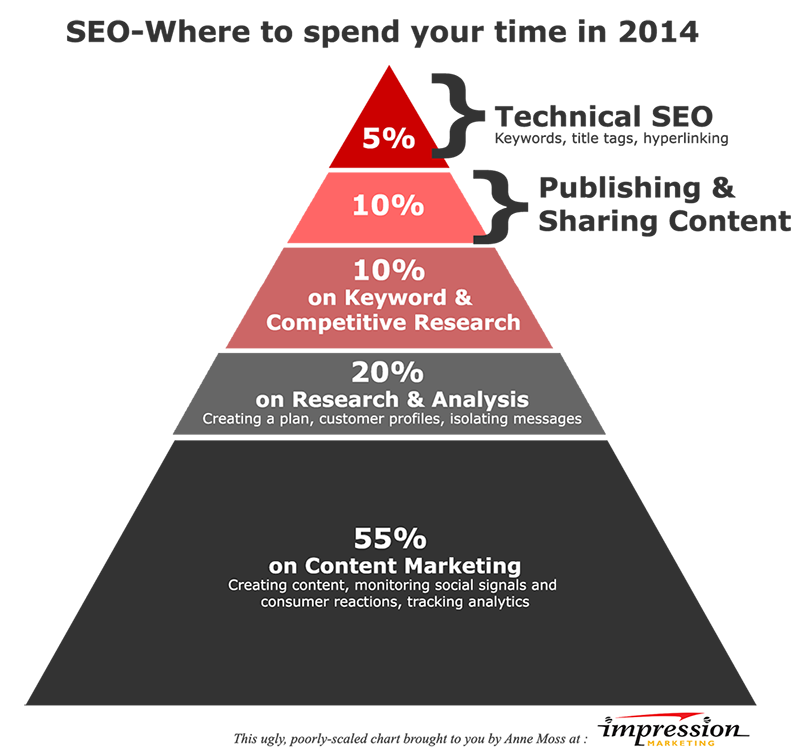
In SEO copywriting, your headline should attract people’s attention, then prompt them to click and read further.
As you learn to become a better writer, focus on the things your leads will see first. Such as the headline.
When you rank in Google’s top 10, if your headline is clickable and attractive, it doesn’t really matter whether you rank #1 or #4, because you will still attract organic visitors to your site. As a rule of thumb, a successful SEO copywriter creates the headline before moving on to the body of your article or blog post.
Note: Headlines that convey a specific message or idea work best with search users. According to Conversion XL, headlines with numbers are always winners. If it makes sense, include a figure in the headline.

Several authority content sites use numbers in their headlines. Three out of 5 of Lifehack’s posts have headlines that use numbers. Sites like Inc, BusinessWeek, Mashable, and Upworthy all understand the psychology behind numbers.
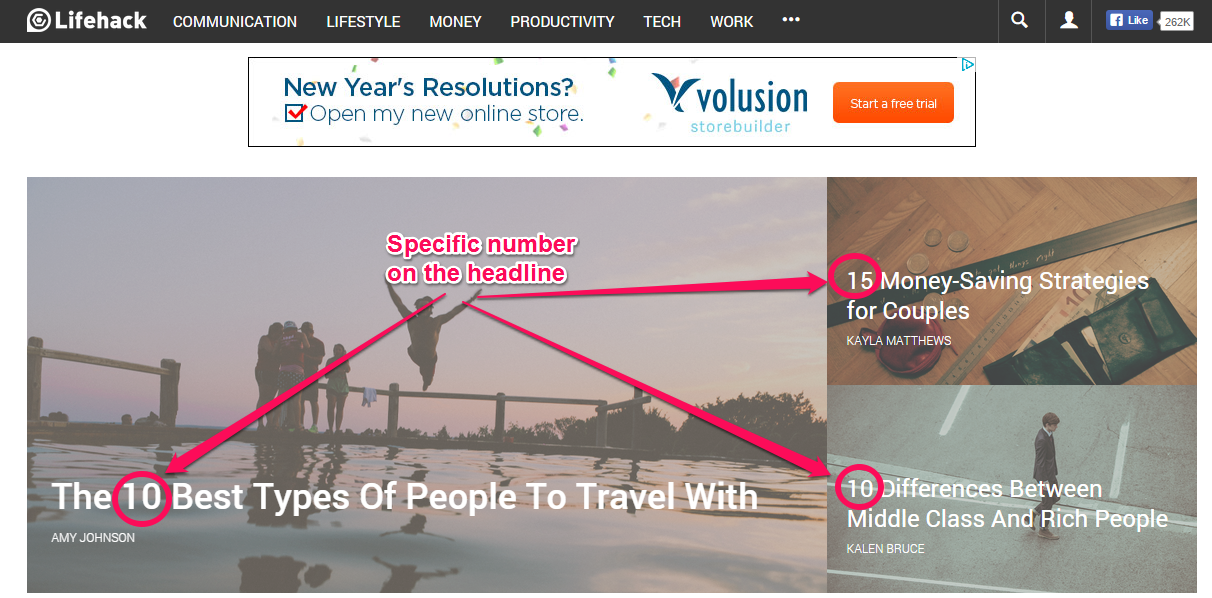
Headlines that have numbers in them usually get shared more on Facebook and Twitter as well. For example, one of the most popular posts on HubSpot is a number-type headline.

Generate article ideas: If you’re stuck and don’t know what to write about, you can use the Inbound Now tool to generate blog post/article ideas before you hire that SEO copywriter.
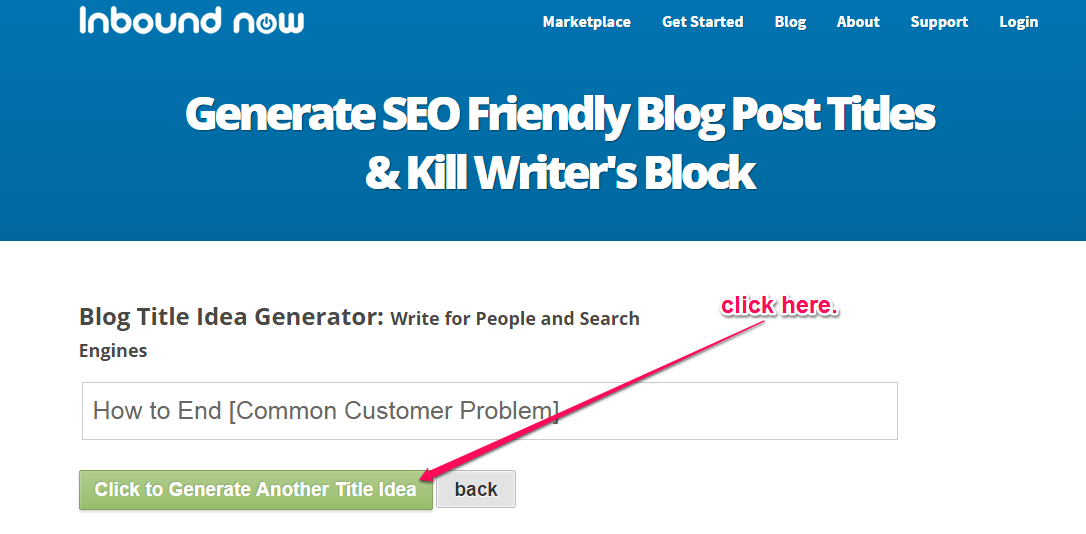
There are several resources for writing click-worthy and sharable headlines. To demonstrate, let’s write some fresh headlines in three popular industries: small business, fitness, and relationships.
Clickable and optimized small business headlines:
- 7 Small Business Trends That Will Affect Your Sales
- How To Start a Small Business That Customers Will Love
- Small Business Funding: How To Raise $20,000 In 60 Days
SEO and user-friendly fitness headlines:
- 10 Workout Secrets For Women That Work
- Best Way To Lose 10 Pounds After Pregnancy
- Personal Trainer Kits: Become a Certified Personal Trainer
Well-optimized and catchy “relationship” headlines:
- 3 Funny Ways To Get Your Ex-Boyfriend Back
- How To Renew Your Love Life with Your Spouse
- What Does It Take To Have a Fabulous Wedding?
Analyzing the search engine results: Let’s say that we do a search in Google for “save money.” You can see that most search results are SEO-friendly (and target a keyword), but some of the headlines themselves are not attractive to the user. Adding a long tail to the title might help for those with specific inquiries.
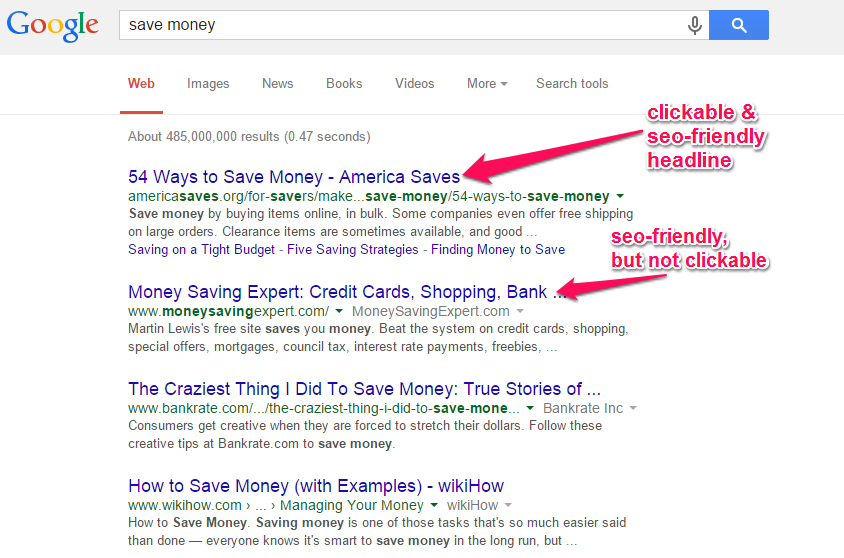
New and experienced SEO copywriters highly recommend downloading Yoast SEO as a WordPress plugin to help optimize SEO copy. Once you learn SEO copywriting, you can write content that will both rank highly in Google result pages and also attract clicks from prospective customers or clients.
Note: If you want your whole title to be visible in search engine results, keep it under 72 characters. This will also increase your click-through rates.
3) Content
The content itself is a vital element of SEO copywriting. The major reason why people conduct searches in Google and other search engines is that they’re looking for useful content. Search engines also feed on fresh SEO content, which is why you must consistently update your site.
Marcus Sheridan grew his swimming pool company from less than 10,000 to 80,000 monthly visitors; within 6 months and he grew his organic traffic by blogging 2 -3 times a week.
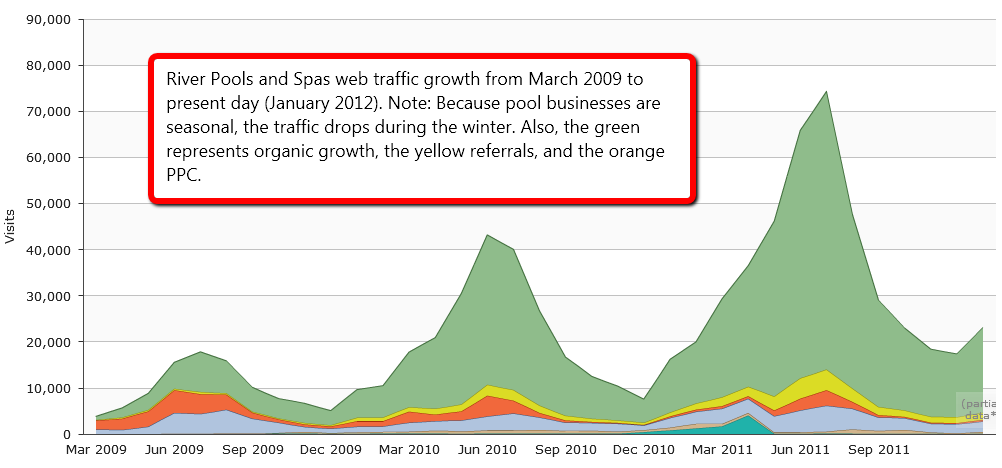
When Marcus began to target long-tail keywords in his blog posts, everything changed. He said that “within hours of writing an article with specific keyword goals, we were showing up on the first page of Google.”

If you want to write the best content that will rank well in Google, you have to target keyword phrases. Avoid stuffing keywords or over-optimization. Ideally, put the keyword in your headline, but make sure that it reads smoothly for your readers.
The Google Panda 4.1 update was designed to penalize “thin” or shallow content, by keeping lousy content from ranking highly in Google. A typical blog post or article should be at least 1000 words. But, it’s not all about length, because several detailed articles still struggle to rank and retain their position in Google results pages.
Before you write your SEO content, it’s essential to understand your reader. Then, niche down and focus on a particular problem that the reader is struggling with. Dare to solve that problem with your content – that’s another goal of combining SEO and copywriting.
Every piece of content you write needs a compelling introduction. The introduction is the portion that comes right after the headline (and sub-headline if you include one in your content). Your introduction should contain at least one of your targeted keyword phrases, especially a long tail keyword.
However, it’s crucial to understand that modern SEO copywriting has gone beyond keyword targeting and placement. The best approach now is to write content that addresses keyword intent. You will learn about that later on…
4) Meta Description
Before writing your content and again, before publishing it, use meta descriptions to help guide search engines. Meta descriptions help search engines and searchers understand what the topic is and why your targeted keywords and phrases keep appearing in the content. This is where SEO firms earn their money, only because they understand this.
Moz noted that the meta description is the HTML attribute that provides a “concise explanation” to the search engines of your page’s content. The tag is enclosed with the <head> section </head> on your web page. This is the code sample:

Google uses the meta description on your page as a snippet when people search for keywords that are relevant to your page. This snippet copy is what will determine whether or not you get clicks, no matter how highly you rank in the search results.
For SEO purposes, the meta description should be 150 – 160 characters and usually appears like this in Google:

Note: If you own a WordPress blog, you can install the All-In-One SEO Pack plugin and use it to set up your title, meta description, and relevant keywords. If you’re new to blogging, this guide will help you set up the plugin.
How do you write meta descriptions that catch people’s attention, as well as rank well in Google?
Step #1: Understand keyword intent. Keyword intent is the main purpose or reason behind keywords (whether seed or long-tail keywords).
For example, say you’re a social media consultant and you want to attract clients to your business. Then, your primary keyword might be “social media expert advice.”
When prospective clients type that keyword into Google search, what do you think they’re really interested in?
What they want is clear – a social media expert with advice on how they can move their online or brick-and-mortar business to the next level.
Maybe they want more Twitter followers, greater engagement or tips on how to acquire more leads. Your meta description has to be relevant and appeal to them.
Step #2: Once your article or blog post has been written, the next thing is to write your meta description. Swell Path recommends you follow this checklist:

To demonstrate, let’s put the tips to work by writing two meta descriptions that are SEO-friendly and relevant to our target audience.
a) Begin with a question: Looking for expert social media tips to acquire new leads, convert visitors to customers, and improve your brand? First, set a definite goal.
Length – 141 characters.
b) State the obvious: Many companies have given up on social media marketing, because they don’t know what to do. All you need is expert advice that has produced success.
Length – 148 characters.
Note: You don’t necessarily need to include your exact keywords in your meta description, especially when it doesn’t flow smoothly. I’ve seen a lot of web pages rank in Google’s top 10 without the main keywords.

5) Keyword Frequency
Keyword frequency means how many times your chosen keywords appear on the web page.
For example, if your target keyword is “best london hotels,” how many times will this exact keyword phrase appear in your 300, 500 or 1000+ word article? In contrast, keyword density is concerned with the ratio of “best london hotels,” to other words on the same page.
Keyword frequency and density are no longer as effective as they used to be, before Google started rolling out frequent updates, but are still important parts of SEO content. Avoid on-page optimization mistakes, like keyword stuffing, excessive keyword insertion and header tag stuffing.
However, keyword density still impacts organic ranking to some extent. According to Brian Dean, keyword density/frequency is one of the 200 ranking factors, which means that you should still consider it. But, don’t go overboard.
Here’s what Brian Clark had to say about it:
The only way to tell if your repetition of keywords is super or spammy is to measure that frequency against the overall length of the content. A keyword density greater than 5.5% could make you guilty of keyword stuffing and your page could be penalized by Google. You don’t need to mindlessly repeat keywords to optimize. In fact, if you do, you’re likely to achieve the opposite result.
To check your keyword density, use the SEObook keyword density tool.
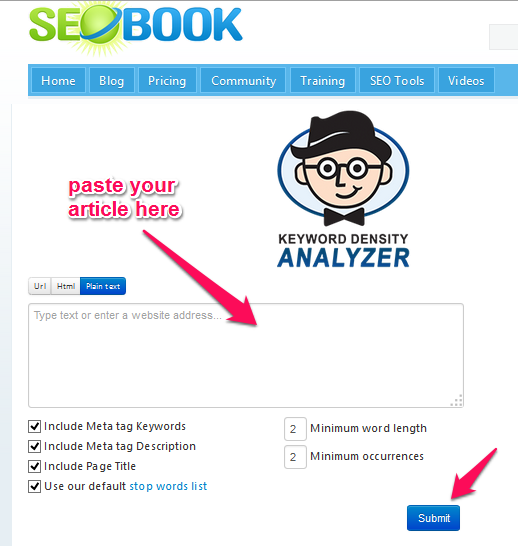
6) Page Links
Links are the basic building blocks of your web page. One of the 10 things Google knows to be true is that “there’s always more information out there.”
Page links tell Google that you’re connected and sociable and that you’ve got useful content that people can access somewhere else. This content could be your own or it could be from another author or site.
Linking out to other authority sites and pages is an indication that you value what other people create. Google will reward you for being in sync with their mission: organizing the world’s information and making it universally accessible. A good marketing team would highly recommend to appropriately link.

What copywriters usually do is to find appropriate keywords, research accurate data and then use both to craft irresistible content. That’s why copywriting is one of the fundamental factors of search engine optimization.
The rules for linking out to other sites are not set in stone. There are also no hard and fast rules for internal linking. However, as a smart online marketer who wants to achieve tremendous results in the search engines, you should:
- Link to relevant pages within and outside your site in your introduction
- Link to more in-depth guides or content on your page or other sites
- Link with appropriate anchor text, which flows naturally with the content
As I said earlier, these rules are not set by Google or other search engines. If you can understand your target audience and you produce the best content that will solve your readers’ problems, you don’t need to worry about keyword density, page links, and social signals, because they will occur naturally.
Remember that the goals of highly useful content include thousands of social shares, comments, leads, clients, and sales. This is your job as the SEO copywriter.
SEO Copywriting Tools and Resources: To fully understand and implement SEO copywriting best practices, you need viable tools and resources. Here are some that I recommend:
Unsuck-it: This is a free web app that you can use to make your words, sentences, and paragraphs flow smoothly. You can replace jargon with fun words in five seconds.

RhymeZone: A lot of people love reading poetry and admire poets. Use this handy tool to make your copy appealing to the right audience.
Read-Able: This simple tool helps you optimize your content for 7th – 8th grade level. This ensures that a wider audience will enjoy your content and click the headline when it shows up in Google results pages.
Live-Keyword-Analysis: Use this free SEO tool to accurately calculate the keyword density ratio for a piece of content.
Kill Writer’s Block: Highly recommend this tool to generate creative ideas for your next blog post.
Quick Sprout: Find out why you’re not generating enough traffic from Google, even when your long-tail keywords are ranking highly.
EMV Headline Analyzer: How much does your headline appeal to your readers’ emotions? I highly recommend this free tool to analyze your headline and give you a score.

Google’s 200 Ranking Factors: The Complete List – this one is self-explanatory.
For a list of other resources and tools that are useful for SEO copywriting, check out Writtent.
Copywriting optimization points: Search engine rankings can’t be predicted, no matter how knowledgeable you are, because Google is always updating their ranking algorithm. If you plan on hiring an SEO firm to create CEO copy, realize they are subject to a changing game as well.
However, there are actions that you can take to increase the likelihood of your web page showing up in Google for relevant search queries. Let’s explore those factors:
Title tags: It’s a good idea to know how to write title tags for search engine optimization. Again, Yoast SEO can help here. The title tag is a meta HTML tag, like the meta description we saw earlier. It is like the title of a book. It’s the first thing that appears in Google search results.

The title tag should be a concise and accurate description of your web page. Google will display 50 – 60 characters of your title in their search results. As well as thinking about length, write titles that will align with your brand.
Moz does highly recommend that the optimal format for your title is: Primary Keyword – Secondary Keyword | Brand Name
For example: Learn CSS online – CSS formatting Tips | WebDesignClub
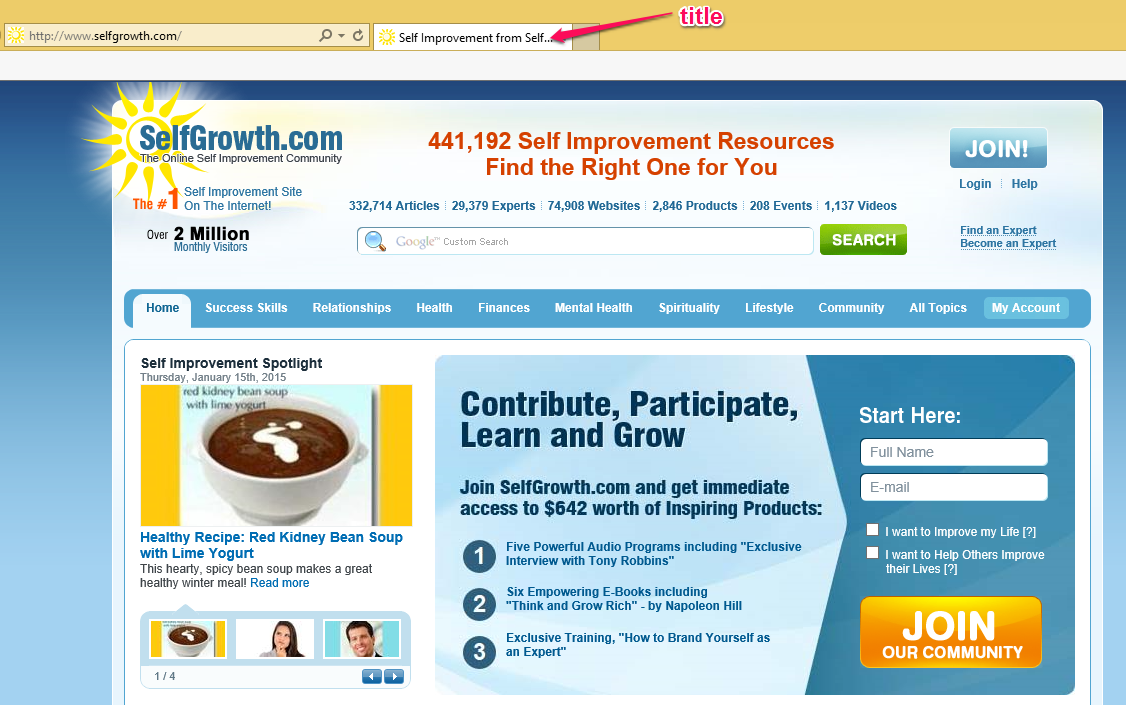
Heading tags: The heading tags are labeled h1 – h6. The heading tags will enlarge your font size and make it stand out. When you write content, it should be well structured for readers.

Optimizing your title: This is one of the most important things that you can do to ensure that your title ranks in Google, as well as attracting an audience. This screenshot of the Moz resource on title tags helps you optimize your titles effectively:
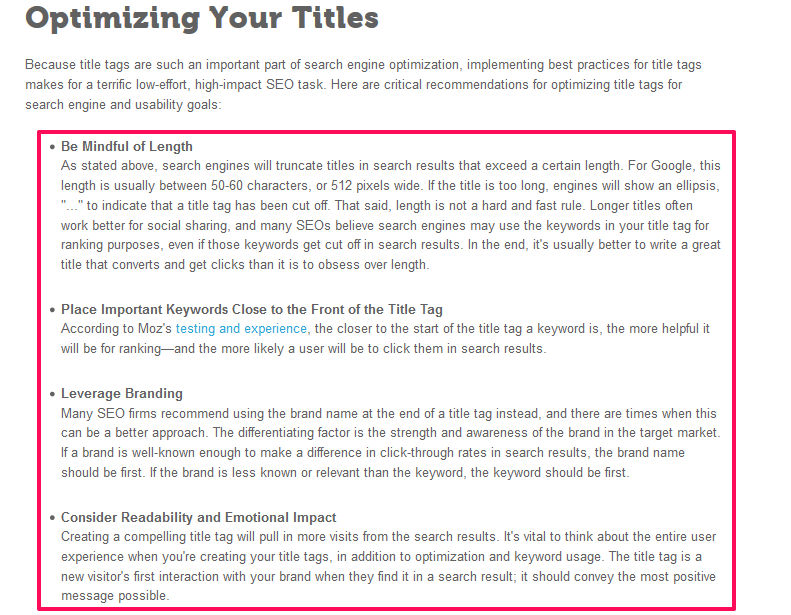
Writing Useful Content For People
Words are powerful. Words drive engagement. If you can piece words together to produce a valuable piece of content, your target audience will love you for it — and they’ll stick around. There is no alternative to writing great content.
The number of blogs that produce fresh content daily is ever-growing. Remember that duplicate content, keyword-stuffed content and low-quality content will not help your target audience. This is not a good SEO content strategy and can’t be emphasized enough. It also won’t do a thing to improve your organic ranking.

One study shows that even if your content is useful, it still needs three additional elements in order to drive organic traffic:
- optimize for many keywords with lots of searches
- gain a reasonable number of trusted backlinks
- write about an evergreen idea/topic
That’s how Brian Dean increased organic traffic by 110% in 14 days.

Keyword Research
Keyword research is still necessary. The most important aspect of any keyword used by search users is the intent. Before you can write great content that solves a particular problem, you’ve got to know what each keyword stands for.
Don’t forget to pay attention to keyword classification. In other words, understand whether search users want to buy a product or not.
There are two important keyword classifications: informational and commercial keywords.
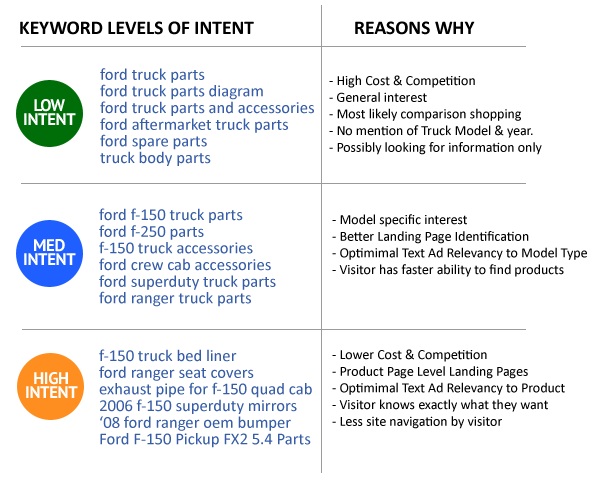
Informational keywords: The major reason why people search with these is that they want useful information without having to pay for it.
Informational keywords are usually “how-to” in nature. Here’s an example from Ubersuggest:
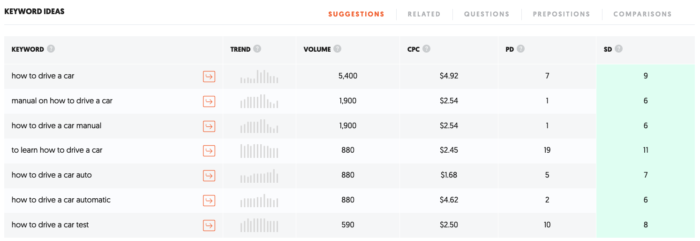
Of the seven keywords on this list, five of them begin with “how-to.”
These are informational because the searchers are probably only interested in free articles, videos, blog posts and lessons.
As an SEO copywriter, you can write useful content around informational keywords, but don’t expect to convert readers into customers, because most of them don’t want to buy. Instead, use informational keywords in your content to nurture an audience, engage them and build your brand.
Commercial keywords: Commercial keywords show an ‘intent’ to buy. These keywords usually show “desperation” from the searcher. They want solutions quickly – e.g., “lose 10 pounds in 3 days.”
The person searching for commercial keywords is likely going to buy a product, or sign up to an email list that will eventually convert them into customers.
The fact that someone typed a commercial keyword into Google means the person is ready to take action. Commercial keywords usually contain certain prefixes and suffixes, like reviews, buy, order, review, comparison, compare, free shipping, best, fast, etc. See this example in the weight loss niche:
Examples of commercial keywords from this list include lose weight gnc product, gnc product to lose weight, herbalife weight lose product, and herbalife product to lose weight.
Note: When you write content around commercial keywords, the ultimate goal is to provide useful information on how to use the product, its benefits and features and how to install it, if that’s required.
Should you target keywords? Yes. Google still uses keywords to gauge what a particular web page is about. Use caution and avoid over-optimization.
I follow a 3-step plan when targeting keywords in my content.
- I include the primary keyword in the headline. For example, if my keyword is: conversion rate optimization. My headline may be, “7 Ways To Make Conversion Rate Optimization Work For You.”
- I use alternative keywords in the introduction, meta description, and title tags. For example, What is the best way to increase your conversion rate with every blog post that you write? You know how important this is, especially when it seems as though your best content isn’t generating organic traffic, social shares, and sales.
- I write naturally to please my readers and then deliberately include the primary keyword in the conclusion.
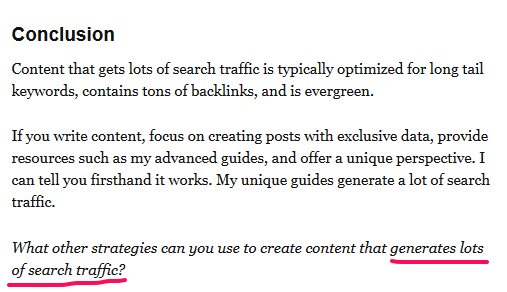
Storytelling
As an SEO copywriter, storytelling can set you apart, because human beings love good stories. If you can weave your brand story into your blog post, article or video, you will attract more attention.
Brand storytelling is not something new. Several brands have used it in the past and still do. According to Kristen Matthews, when you use natural storytelling in your content, you can make the maximum impact on the reader.
I’ve shared the story of how a Ferrari made me a million bucks. I also wrote a blog post on how spending $162,301.42 on clothes made me $692,500. So far, the two posts have been shared more than thousands of times on Facebook, Twitter and Google+ combined.

A great example of a successful brand story is The Lego Movie. According to Marcus Sheridan, who is also a great storyteller, “Lego doesn’t sell ‘blocks’ at all, they sell possibilities.”
(Read the full story here: The Best Example of Brand Storytelling Ever: The Lego Movie.)

In other words, your story should show others the possibility of achieving the same results. Your story shouldn’t be about you alone, however. Instead, find a way to make it appealing to your target audience.
That’s when brand storytelling will help improve your organic ranking, traffic and sales conversions.
Use Humor
One of the reasons why you should write with humor is to keep the reader/audience engaged. You can also infuse humor to simplify an uncomfortable or controversial topic.
SEO copywriting is not just about writing useful content that solves a particular problem in a boring manner. Your content also has to excite your readers.
They should be excited to click your headline, read the introduction and then move slowly down the body. That’s what it means to write persuasively. If you can do that, it doesn’t matter what you create: people will love it. Whatever you highly recommend, they will buy.
Here’s an example. A professional blogger and public speaker who usually adds humor to her content is Marie Forleo. Each of her video intros always entertains me.
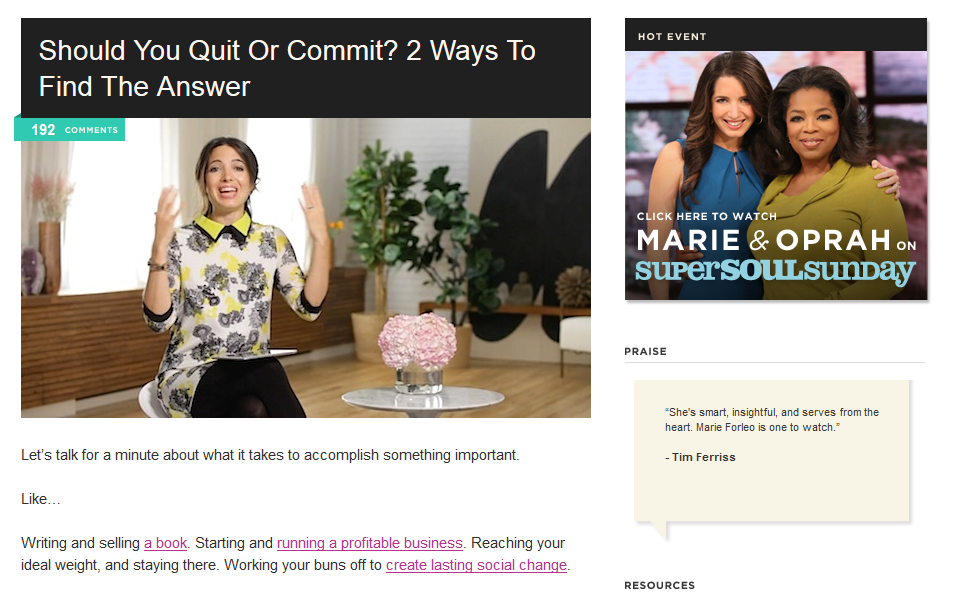
Use Case Studies
Case studies are one of the 15 types of content that will drive more traffic to your site. Case studies can make for powerful content. I’ve seen them rank in Google’s top 10 several times, because they’re highly useful.
A study at Content Marketing Institute shows that B2B buyers prefer case studies and research-based content.
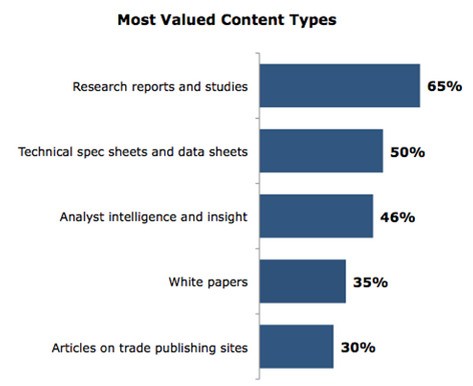
If you consistently write useful and detailed case studies, your major long-tail keywords will start showing up in Google’s top 10 for relevant keywords.
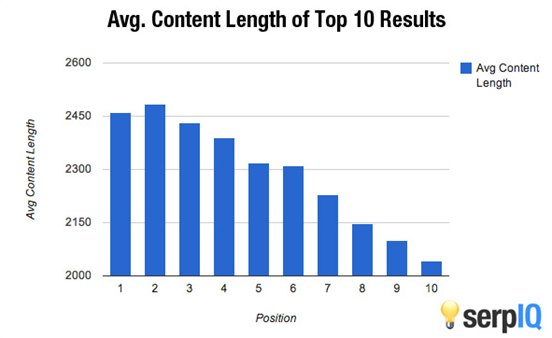
Case studies usually explain what your products and services are. A good case study will show the experiments, research studies and interviews that you conducted, as well as the results that you got. An SEO firm can help in analytics but isn’t absolutely necessary.
You can share any type of case study, even ones that didn’t get the results you hoped for. If you want to create a valuable and optimized case study, this screenshot will guide you:
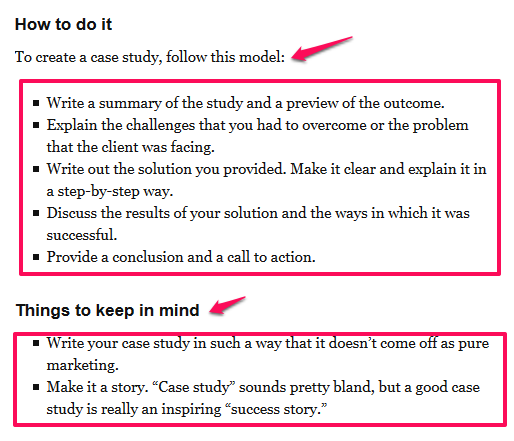
Keyword Research for Content Creation
The first five sites that come up in a google search get 67.6% of the clicks.
More than 66% of all clicks go to the top 3 search engine results. If you want to tap into this rare opportunity to rank in the top 5 positions, then you should learn keyword research best practices.
Long-tail keywords are the best way to go in modern SEO because top brands are not targeting those terms. And, if you can produce good content while naturally targeting these types of keywords, you will definitely dominate the search engines.
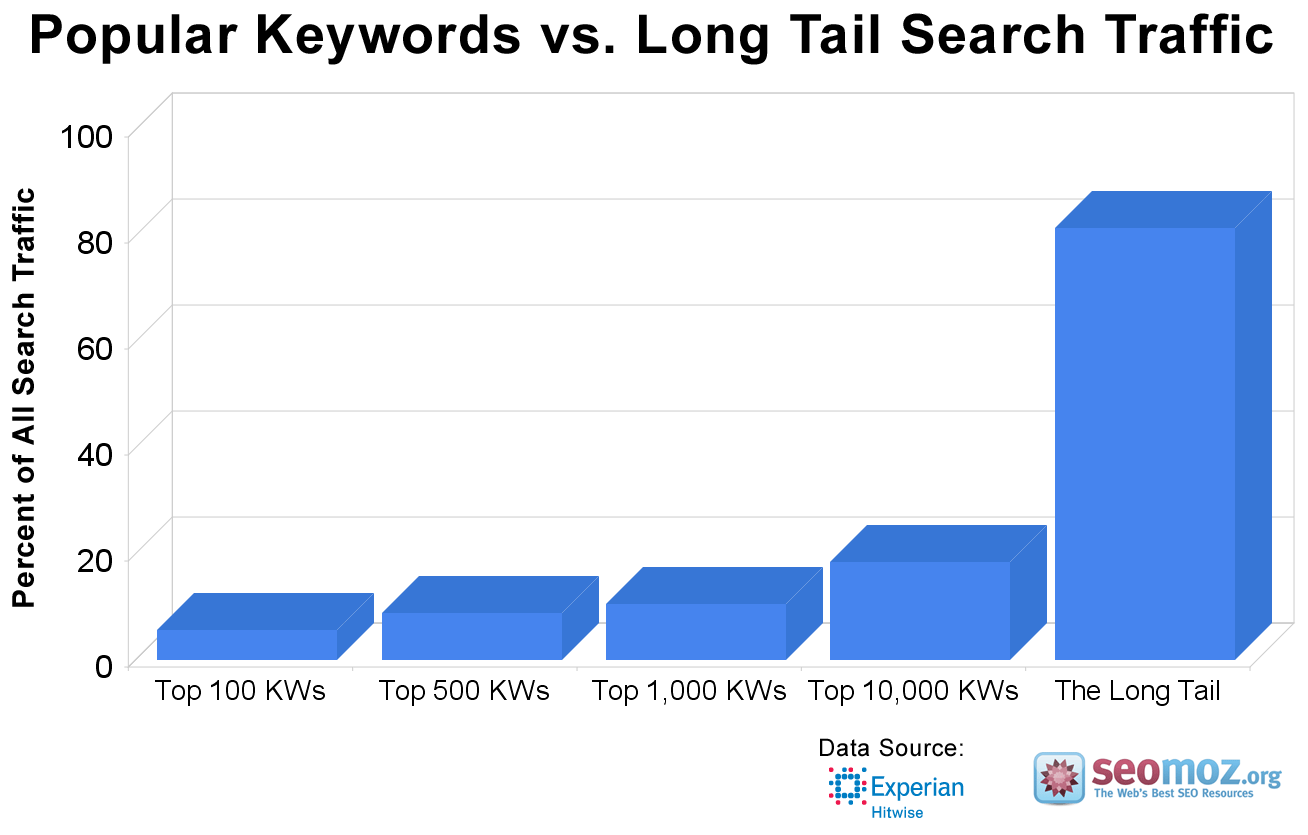
SEO isn’t complete without keyword research. That’s part of how you determine the mindset and intent of your target audience. Long tails help define that mindset.
In niche marketing, picking the right keywords is the most challenging aspect of building a profitable niche site.
Once you’ve chosen your topic, it’s time to find relevant keywords in that industry. Let’s find keywords for “waterproof digital cameras.”
Go to Ubersuggest. Plug the topic into the search box, then click “Search.”

Here’s what the search returns:
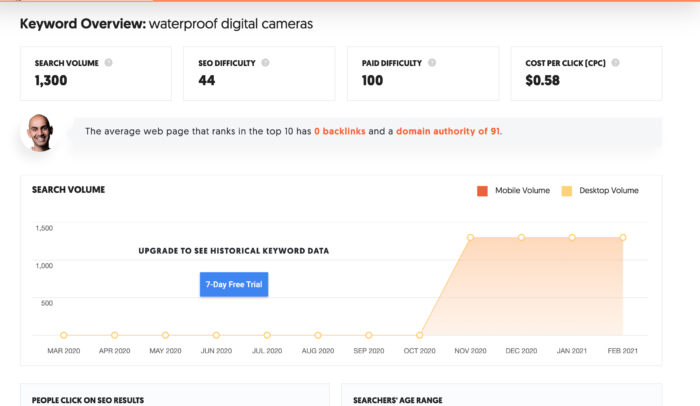
- Search volume – number of searches the keyword has during a month
- SEO difficulty – estimated competition in organic search
- Paid difficulty – estimated competition in paid search
- Cost per click – average cost per click for a Google Ad
You’re also provided an overview of what it takes, on average, in terms of backlinks and domain score, to reach the first page of Google for the keyword. This is located above a chart displaying the keyword search volume over the past 12 month period. Pay close attention to any dips in traffic. For this particular keyword, it’s natural for volume to drop off during the fall and winter months.
As you scroll down the page, you’ll find a list of long-tail keywords that we can optimize our content for:
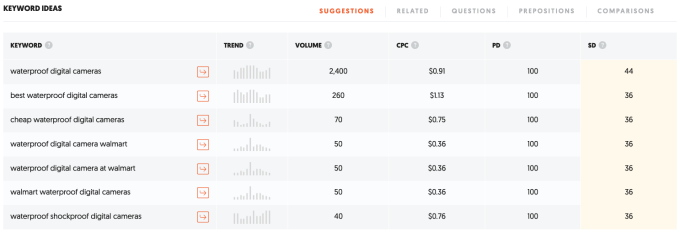
From this list, “best waterproof digital cameras” is a good choice, as the search volume is still high enough to move the needle.
Optimizing content for search robots: Search engine robots or web robots (e.g. crawlers, spiders and so on) are programs that constantly scour the web.
When a Google spider crawls your web page, it’s looking for fresh content. Some people even say that spiders/crawlers feed on fresh content and will reward you for freshly updating your site regularly.
However, understand that when Google spiders index (add your fresh content to their search database), they’re only interested in the meta tags (title tag and meta description).
More importantly, they want to know the keywords that you’re targeting. This helps Google determine the industry your content will benefit, e.g., health, business, small business, internet marketing, etc.
For best results, you should optimize for search robots like this:
- add the primary keyword in your title tag and meta description
- add alternative keywords in your introduction and make sure that it flows well; if the keyword doesn’t flow well, ignore it and just write naturally.
Keywords like “best seo web design NY” won’t work in the title tag, description and content. The best approach is to use the keyword naturally, like this:
How To Find The Best SEO Firm and Web Design In NY
On-Page SEO Copywriting
On-page SEO doesn’t have to be tedious or complicated. A lot of posts have been written to address this topic.
Elements that add value to your site, such as internal links, are very important.
You control 98% of what happens within your site.
That’s why Google pays attention to your web pages and measures the engagement, bounce rate, retention rate, and social shares.
The foundation of an effective SEO campaign is what happens in-house (on your site). In other words, pay attention to how you target your keywords, which anchor is used to link internal pages, meta tags, etc.
This on-page optimization infographic from Backlinko will show you what matters when it comes to creating SEO-friendly content pages.

Off-page Optimization
In today’s digital marketing, the public determines how relevant and useful your content is. And, Google uses off-page factors to gauge the authority and value of your content pages.
Generally, you can’t control what happens outside your site. For example, you don’t control who links to you and you don’t control the quality of sites that choose to reference your work.
If you’re smart, you can use off-page SEO techniques to build a solid brand online and increase organic traffic.
According to Chris Ainsworth, the 5 proven off-page SEO strategies that work well are:
- Build and engage a raving community through social media
- Expose your business and take advantage of local SEO
- Instill brand confidence through business reviews
- Promote local citation and Name/Address/Phone (NAP) consistency
- Link building through blogging, guest posting, competitor link analysis, blog outreach, networking, and dofollow blog commenting.
Getting People to Act Through SEO Copywriting
The final piece of the puzzle in this in-depth article is “persuasion” — the ability of your copy to drive people to action. This isn’t difficult, because there are many high-quality resources and tools that you can use.
Copy is written to sell a product, service, or idea. It all begins with selling yourself, because you’ve only got a maximum of 30 seconds to sell yourself and leave people wanting more.
One of the ways to push people into action is to highlight the key points of your content or topic using bullet points. Before you write blog posts or articles, Vivian Giang recommends you list 3 or 4 strong benefits that you will cover. This is very important, as it also helps you create powerful headlines and paragraphs.
Derek Halpern, founder of Social Triggers, a giant SEO firm, combines the power of psychology and copywriting to produce compelling content. He also employs the same strategy on his landing page.
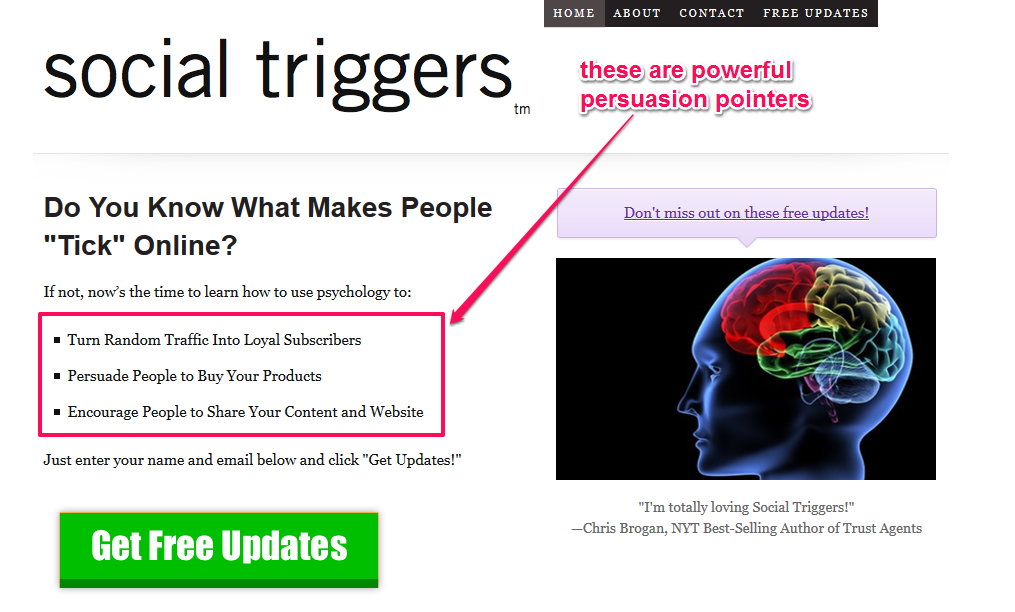
Create Irresistible and Valuable Headlines
Columbia University recognized headlines as the most important element of copy. They advise that you think like a reader and write the headline first. The headline should target a keyword and also look attractive.
Let’s craft more clickable headlines, using some of the results in Google. When I search for “diet plans,” here are the results I get:
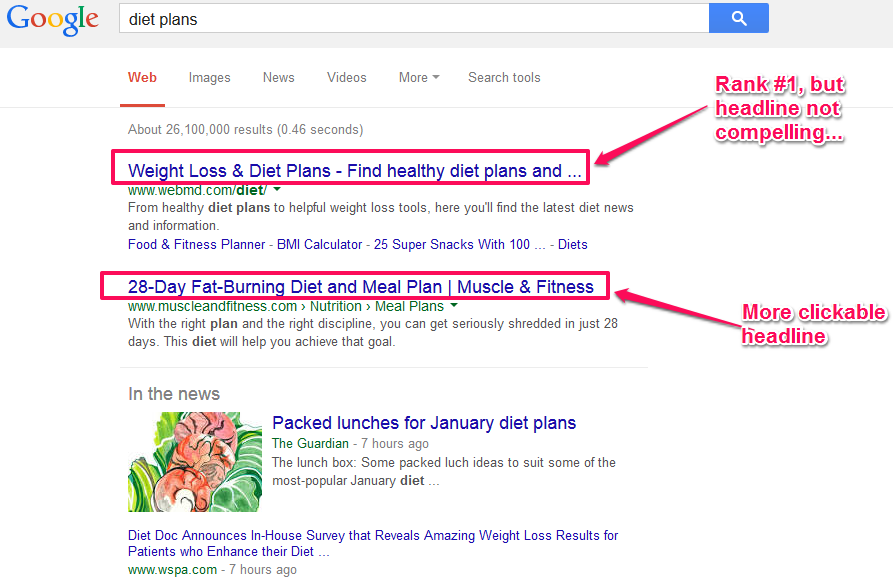
The screenshot above shows the headlines showing up at #1 and #2 in Google for the keyword “diet plans.”
Original headline: Weight Loss & Diet Plans – Find Healthy Diet Plans And…
Here’s a much better headline: The Best Diet Plans To Help You Stay Fit
Original headline: 28-Day Fat-Burning Diet and Meal Plan | Muscle & Fitness
Let’s make the headline more compelling and useful: 28-Day Diet Plans That Will Help You Burn Fat
BodyBuilding.com has compelling, catchy headlines that are the right length (50 – 60 characters) and target a particular keyword.

Have Clarity of Purpose
Getting clear with your copy, blog post and message is very important. Wider Funnel increased their conversion rate from 10% to 277%, just by implementing clearer call-to-action buttons and reducing the number of form fields.
When you write content for your blog, focus on one idea and write your post to address a challenge, solve a problem or explain a complicated issue.
According to Success Consciousness, here are some of the ways that you can achieve clarity of purpose as you write your content:
- Know exactly what you want, before you write it — e.g., How to Save $100 in the Grocery Store.
- Use the word “you,” when writing for B2C customers and “we,” when your recipients are mostly business organizations.
- Research accurate data that are relevant to your topic. This study by Conversion XL shows that using a data-driven approach and creating infographics that have accurate data points will improve social shares.
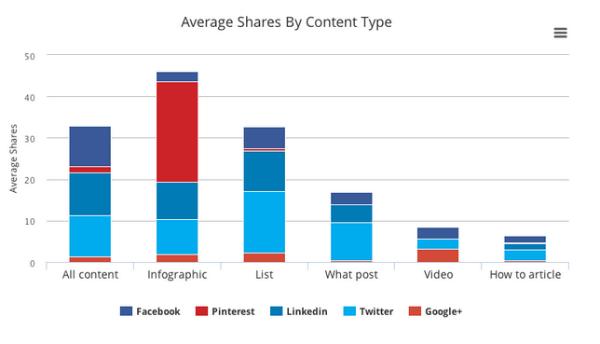
- Target 2 – 5 keywords in a blog post and ensure they read naturally. See an example below. If you read it aloud, you will notice how the keywords flow smoothly with the rest of the content.

Conclusion
I’ve used these SEO strategies to increase my blog’s traffic by 206%. Even if you don’t achieve the same growth rate, by following these SEO copywriting strategies you are more likely to absolutely generate more traffic, improve your brand, and fall in love with content marketing.
If you want experts to help you with SEO for your website, we’re here to help.
What’s your take on SEO copywriting? Do you think it’s a major factor for online content marketing success?
See How My Agency Can Drive Massive Amounts of Traffic to Your Website
- SEO – unlock massive amounts of SEO traffic. See real results.
- Content Marketing – our team creates epic content that will get shared, get links, and attract traffic.
- Paid Media – effective paid strategies with clear ROI.
SEO
Google Confirms Links Are Not That Important

Google’s Gary Illyes confirmed at a recent search marketing conference that Google needs very few links, adding to the growing body of evidence that publishers need to focus on other factors. Gary tweeted confirmation that he indeed say those words.
Background Of Links For Ranking
Links were discovered in the late 1990’s to be a good signal for search engines to use for validating how authoritative a website is and then Google discovered soon after that anchor text could be used to provide semantic signals about what a webpage was about.
One of the most important research papers was Authoritative Sources in a Hyperlinked Environment by Jon M. Kleinberg, published around 1998 (link to research paper at the end of the article). The main discovery of this research paper is that there is too many web pages and there was no objective way to filter search results for quality in order to rank web pages for a subjective idea of relevance.
The author of the research paper discovered that links could be used as an objective filter for authoritativeness.
Kleinberg wrote:
“To provide effective search methods under these conditions, one needs a way to filter, from among a huge collection of relevant pages, a small set of the most “authoritative” or ‘definitive’ ones.”
This is the most influential research paper on links because it kick-started more research on ways to use links beyond as an authority metric but as a subjective metric for relevance.
Objective is something factual. Subjective is something that’s closer to an opinion. The founders of Google discovered how to use the subjective opinions of the Internet as a relevance metric for what to rank in the search results.
What Larry Page and Sergey Brin discovered and shared in their research paper (The Anatomy of a Large-Scale Hypertextual Web Search Engine – link at end of this article) was that it was possible to harness the power of anchor text to determine the subjective opinion of relevance from actual humans. It was essentially crowdsourcing the opinions of millions of website expressed through the link structure between each webpage.
What Did Gary Illyes Say About Links In 2024?
At a recent search conference in Bulgaria, Google’s Gary Illyes made a comment about how Google doesn’t really need that many links and how Google has made links less important.
Patrick Stox tweeted about what he heard at the search conference:
” ‘We need very few links to rank pages… Over the years we’ve made links less important.’ @methode #serpconf2024″
Google’s Gary Illyes tweeted a confirmation of that statement:
“I shouldn’t have said that… I definitely shouldn’t have said that”
Why Links Matter Less
The initial state of anchor text when Google first used links for ranking purposes was absolutely non-spammy, which is why it was so useful. Hyperlinks were primarily used as a way to send traffic from one website to another website.
But by 2004 or 2005 Google was using statistical analysis to detect manipulated links, then around 2004 “powered-by” links in website footers stopped passing anchor text value, and by 2006 links close to the words “advertising” stopped passing link value, links from directories stopped passing ranking value and by 2012 Google deployed a massive link algorithm called Penguin that destroyed the rankings of likely millions of websites, many of which were using guest posting.
The link signal eventually became so bad that Google decided in 2019 to selectively use nofollow links for ranking purposes. Google’s Gary Illyes confirmed that the change to nofollow was made because of the link signal.
Google Explicitly Confirms That Links Matter Less
In 2023 Google’s Gary Illyes shared at a PubCon Austin that links were not even in the top 3 of ranking factors. Then in March 2024, coinciding with the March 2024 Core Algorithm Update, Google updated their spam policies documentation to downplay the importance of links for ranking purposes.
The documentation previously said:
“Google uses links as an important factor in determining the relevancy of web pages.”
The update to the documentation that mentioned links was updated to remove the word important.
Links are not just listed as just another factor:
“Google uses links as a factor in determining the relevancy of web pages.”
At the beginning of April Google’s John Mueller advised that there are more useful SEO activities to engage on than links.
Mueller explained:
“There are more important things for websites nowadays, and over-focusing on links will often result in you wasting your time doing things that don’t make your website better overall”
Finally, Gary Illyes explicitly said that Google needs very few links to rank webpages and confirmed it.
I shouldn’t have said that… I definitely shouldn’t have said that
— Gary 鯨理/경리 Illyes (so official, trust me) (@methode) April 19, 2024
Why Google Doesn’t Need Links
The reason why Google doesn’t need many links is likely because of the extent of AI and natural language undertanding that Google uses in their algorithms. Google must be highly confident in its algorithm to be able to explicitly say that they don’t need it.
Way back when Google implemented the nofollow into the algorithm there were many link builders who sold comment spam links who continued to lie that comment spam still worked. As someone who started link building at the very beginning of modern SEO (I was the moderator of the link building forum at the #1 SEO forum of that time), I can say with confidence that links have stopped playing much of a role in rankings beginning several years ago, which is why I stopped about five or six years ago.
Read the research papers
Authoritative Sources in a Hyperlinked Environment – Jon M. Kleinberg (PDF)
The Anatomy of a Large-Scale Hypertextual Web Search Engine
Featured Image by Shutterstock/RYO Alexandre
SEO
How to Become an SEO Lead (10 Tips That Advanced My Career)
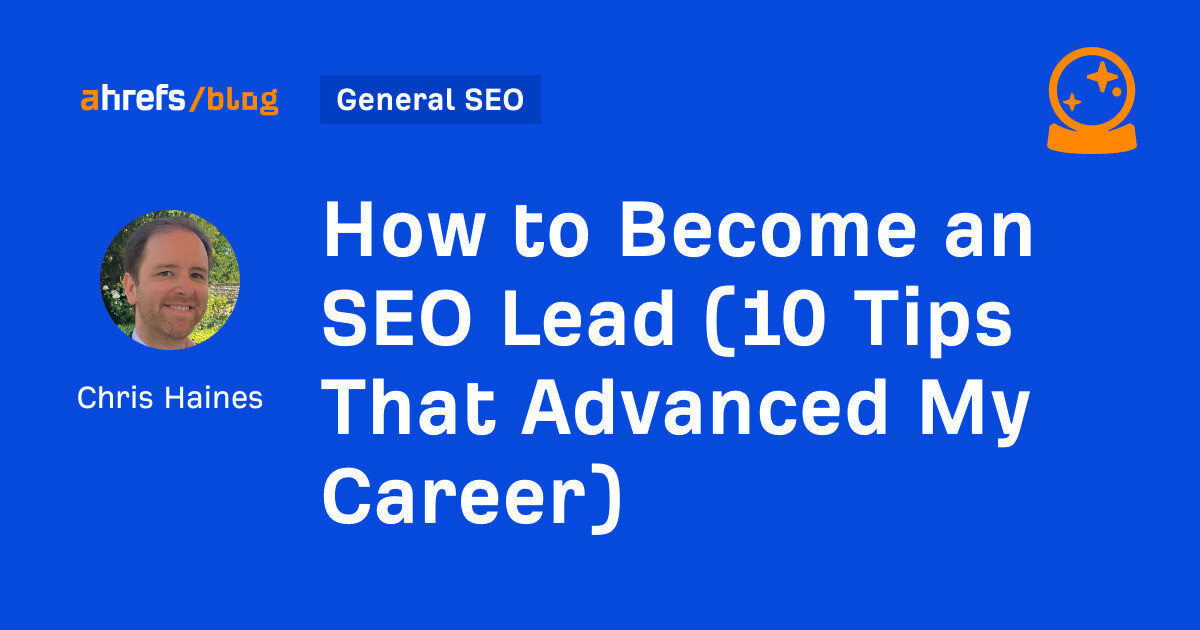
A few years ago, I was an SEO Lead managing enterprise clients’ SEO campaigns. It’s a senior role and takes a lot of work to get there. So how can you do it, too?
In this article, I’ll share ten tips to help you climb the next rung in the SEO career ladder.
Helping new hires in the SEO team is important if you want to become an SEO Lead. It gives you the experience to develop your leadership skills, and you can also share your knowledge and help others learn and grow.
It demonstrates you can explain things well, provide helpful feedback, and improve the team’s standard of work. It shows you care about the team’s success, which is essential for leaders. Bosses look for someone who can do their work well and help everyone improve.
Here are some practical examples of things I did early in my career to help mentor junior members of the team that you can try as well:
- Hold “lunch and learn” sessions on topics related to SEO and share case studies of work you have done
- Create process documents for the junior members of the team to show them how to complete specific tasks related to your work
- Compile lists of your favorite tools and resources for junior members of the team
- Create onboarding documents for interns joining the company
Wouldn’t it be great if you could look at every single SEO Lead’s resume? Well, you already can. You can infer ~70% of any SEO’s resume by spying on their LinkedIn and social media channels.
Type “SEO Lead” into LinkedIn and see what you get.
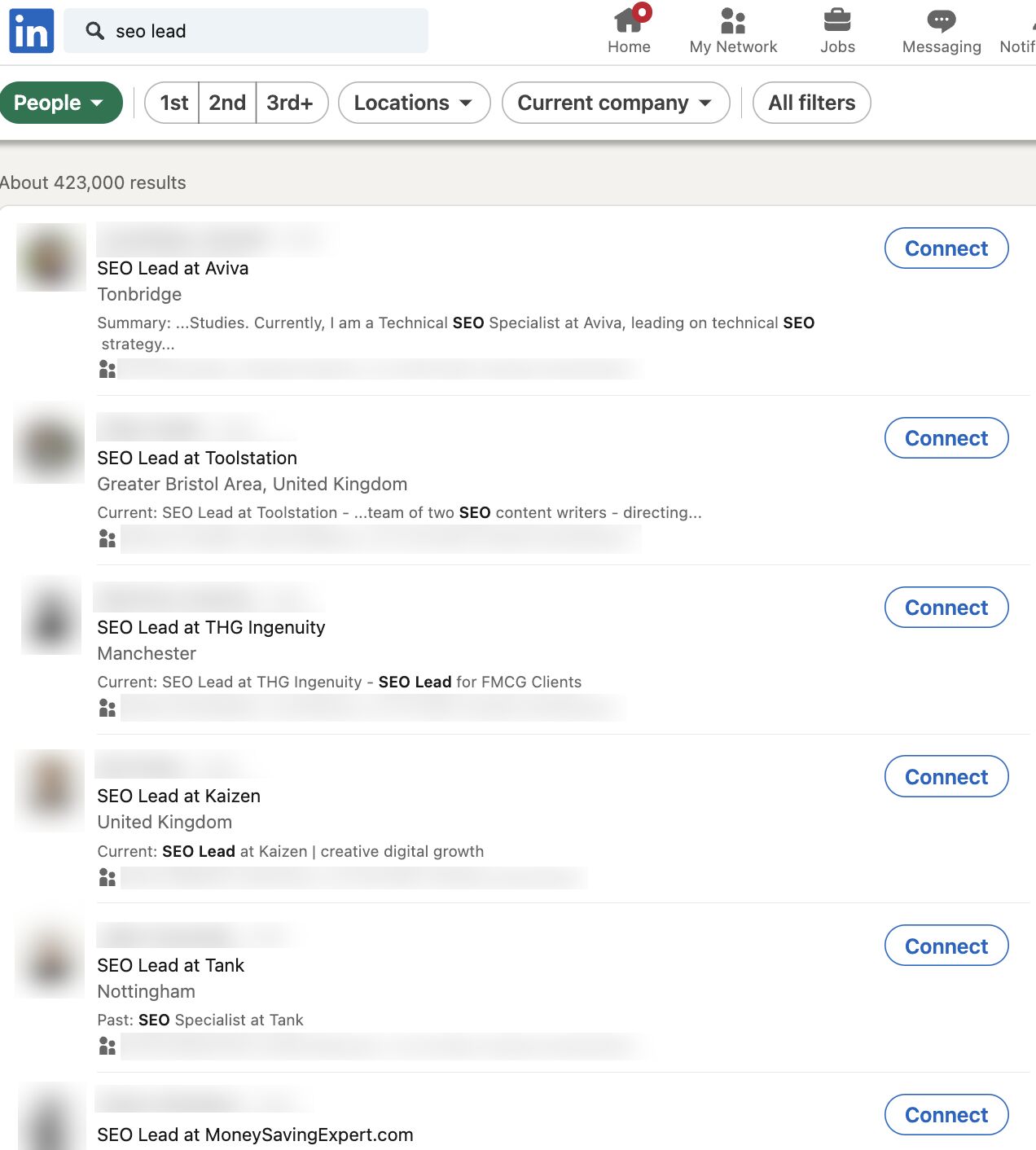
Tip
Look for common career patterns of the SEOs you admire in the industry.
I used this method to understand how my favorite SEOs and people at my company navigated their way from a junior role to a senior role.
For example, when the Head of SEO at the time Kirsty Hulse, joined my team, I added her on LinkedIn and realized that if I wanted to follow in her footsteps, I’d need to start by getting the role of SEO Manager to stand any possible chance of leading SEO campaigns like she was.
The progression in my company was from SEO Executive to Senior SEO Executive (Junior roles in London, UK), but as an outsider coming into the company, Kirsty showed me that it was possible to jump straight to SEO Manager given the right circumstances.
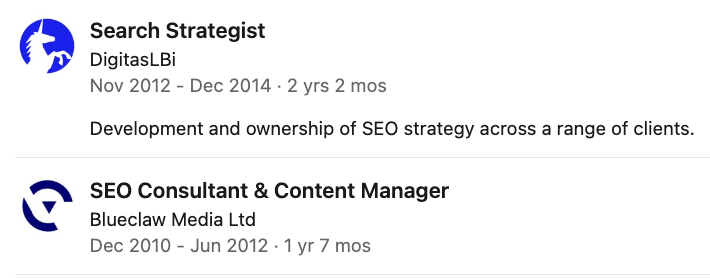

Using Kirsty’s and other SEOs’ profiles, I decided that the next step in my career needed to be SEO Manager, and at some point, I needed to get some experience with a bigger media agency so I could work my way up to leading an SEO campaign with bigger brands.
Sadly, you can’t just rock up to a monthly meeting and start leading a big brand SEO campaign. You’ll need to prove yourself to your line manager first. So how can you do this?
Here’s what I’d suggest you do:
- Create a strong track record with smaller companies.
- Obsessively share your wins with your company, so that senior management will already know you can deliver.
- At your performance review, tell your line manager that you want to work on bigger campaigns and take on more responsibility.
If there’s no hope of working with a big brand at your current job, you might need to consider looking for a new job where there is a recognizable brand. This was what I realized I needed to do if I wanted to get more experience.
Tip
Get recruiters on LinkedIn to give you the inside scoop on which brands or agencies are hiring. Ask them if you have any skill gaps on your resume that could prevent you from getting a job with these companies.
Being critical of your skill gaps can be hard to do. I found the best way to identify them early in my career was to ask other people—specifically recruiters. They had knowledge of the industry and were usually fairly honest as to what I needed to improve.
From this, I realized I lacked experience working with other teams—like PR, social, and development teams. As a junior SEO, your mind is focused 99% on doing SEO, but when you become more senior, your integration with other teams is important to your success.
For this reason, I’d suggest that aspiring SEO Leads should have a good working knowledge of how other teams outside of SEO operate. If you take the time to do this, it will pay dividends later in your career:
- If there are other teams in your company, ask if you can do some onboarding training with them.
- Get to know other team leads within your company and learn how they work.
- Take training courses to learn the fundamentals of other disciplines that complement SEO, such as Python, SQL, or content creation.
Sometimes, employers use skill gaps to pay you less, so it’s crucial to get the skills you need early on…
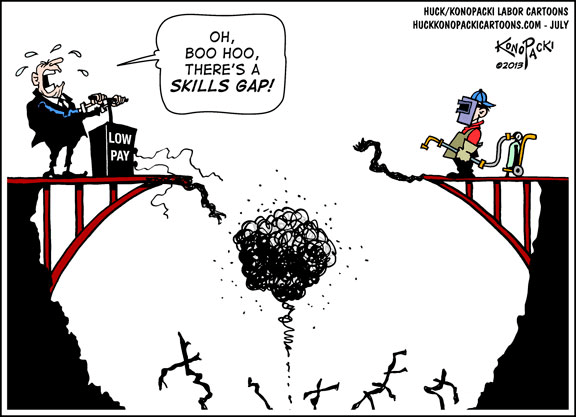

Examples of other skill gaps I’ve noticed include:
Tip
If you think you have a lot of skill gaps, then you can brush up your skills with our SEO academy. Once you’ve completed that, you can fast-track your knowledge by taking a course like Tom Critchlow’s SEO MBA, or you can try to develop these skills through your job.
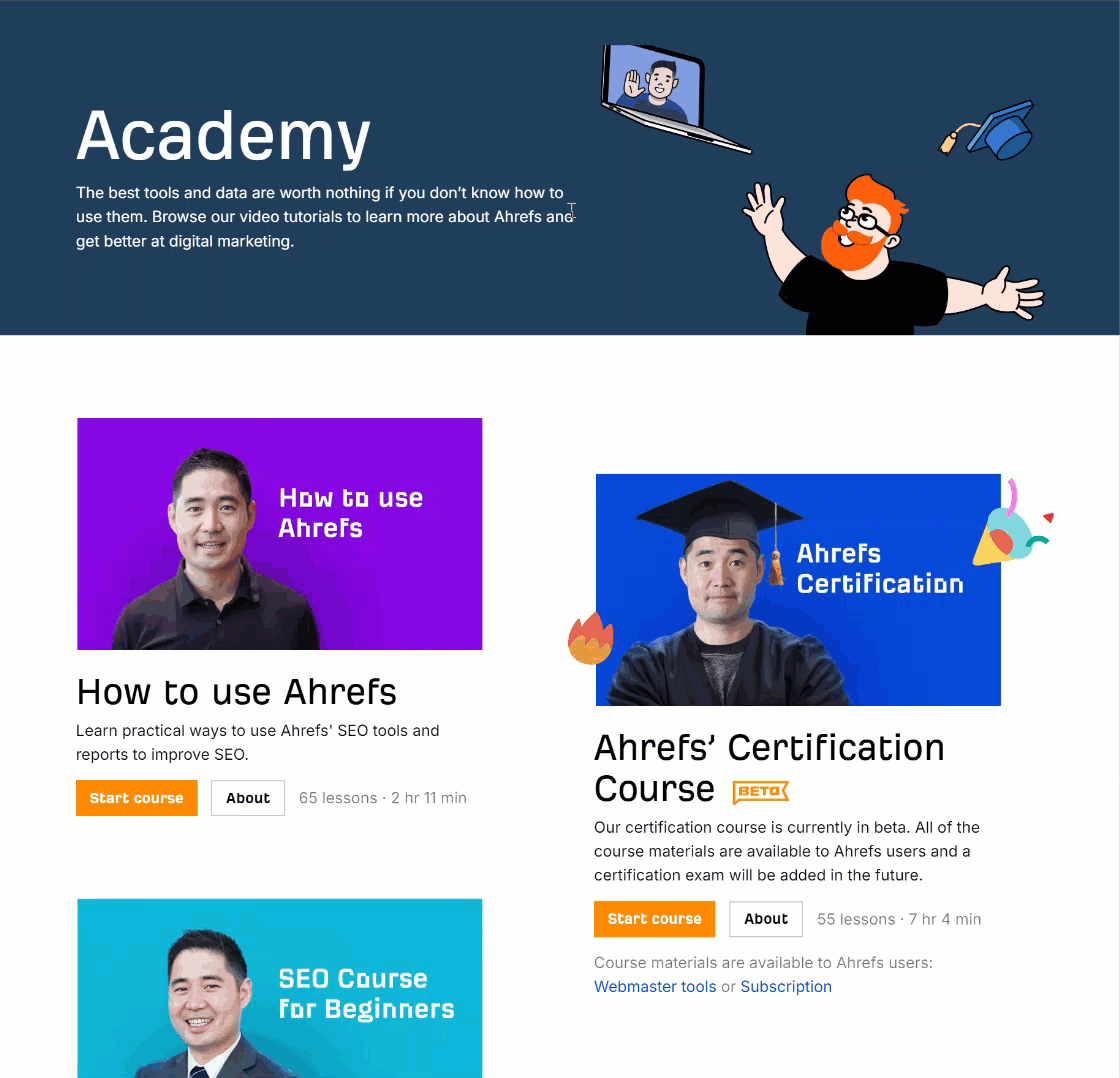

As a junior in any company, it can be hard to get your voice heard amongst the senior crowd. Ten years ago, I shared my wins with the team in a weekly group email in the office.
Here’s what you should be sharing:
- Praise from 3rd parties, e.g. “the client said they are impressed with the work this month.”
- Successful performance insights, e.g “following our SEO change, the client has seen X% more conversions this month.”
- Examples of the work you led, e.g. if your leadership and decision-making led to good results, then you need to share it.
At Ahrefs I keep a “wins” document. It’s just a simple spreadsheet that lists feedback on the blog posts I’ve written, the links I’ve earned and what newsletters my post was included in. It’s useful to have a document like this so you have a record of your achievements.
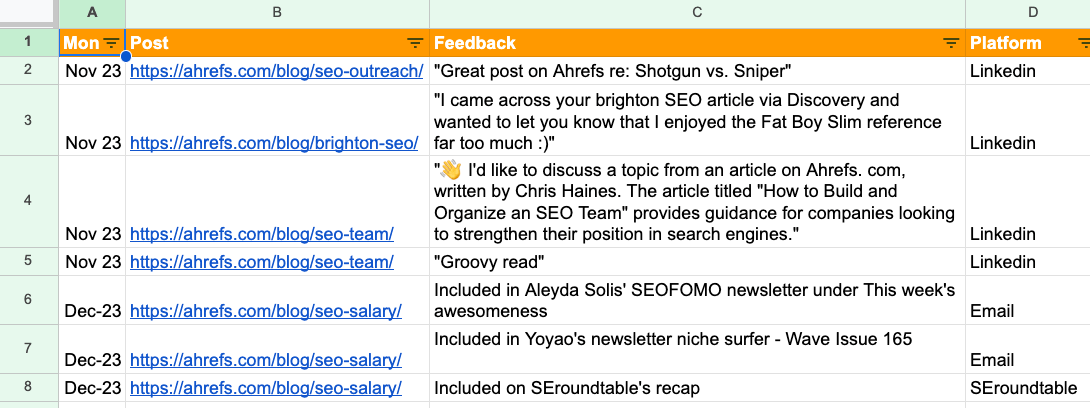

Sidenote.
Junior SEOs sometimes talk about the things “we” achieved as a team rather than what they achieved at the interview stage. If you want the SEO Lead role, remember to talk about what you achieved. While there’s no “I” in team, you also need to advocate for yourself.
One of my first big wins as an SEO was getting a link from an outreach campaign on Buzzfeed. When I went to Brighton SEO later that year and saw Matthew Howells-Barby sharing how he got a Buzzfeed link, I realized that this was not something everyone had done.
So when I did manage to become an SEO Lead, and my team won a prize in Publicis Groupe for our SEO performance, I made sure everyone knew about the work we did. I even wrote a case study on the work for Publicis Groupe’s intranet.
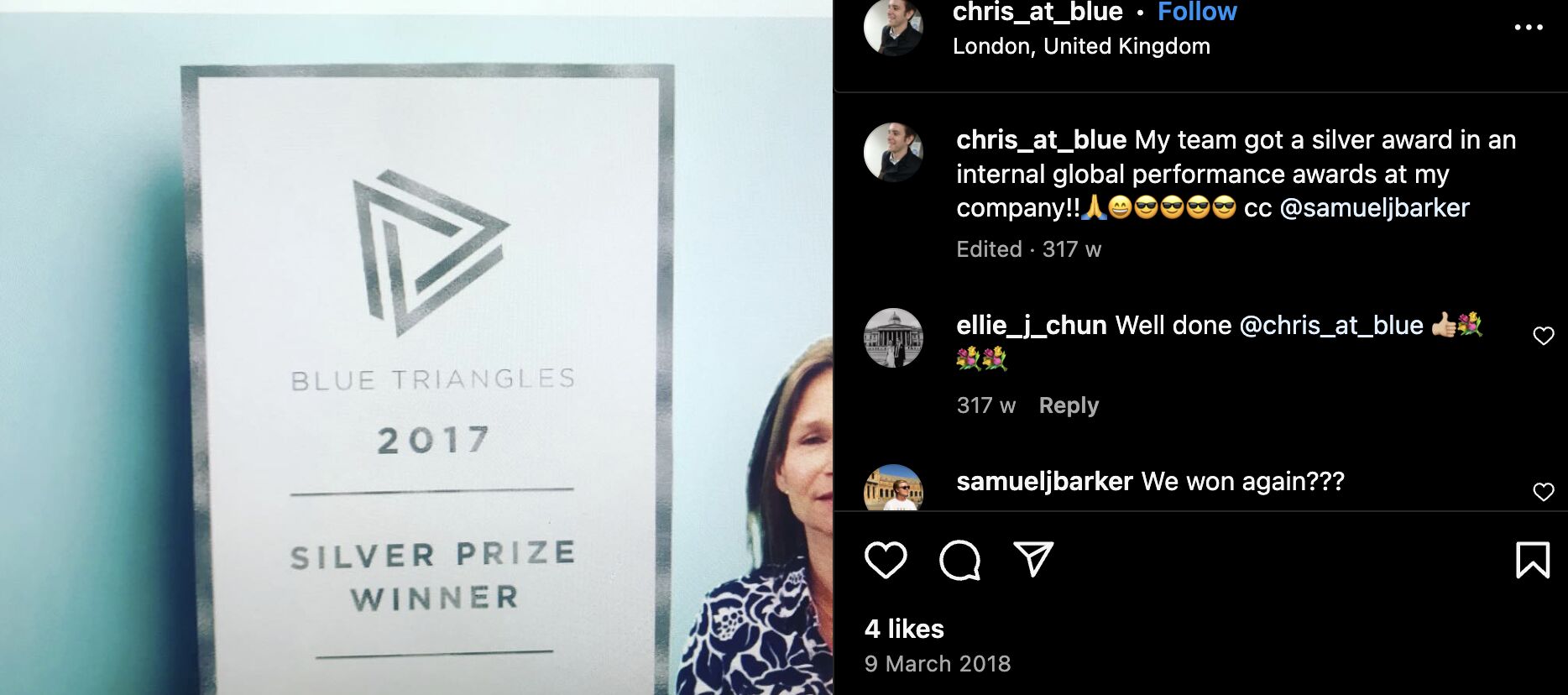

I’ve worked with some incredibly talented people, many of whom have helped me in my career.
I owe my big break to Tim Cripps, Laura Scott, and Kevin Mclaren. Without their support and encouragement, I wouldn’t be where I am today. Even before that, David Schulhof, Jodie Wheeler, and Carl Brooks let me mastermind some bonkers content campaigns that were lucky enough to succeed:


I wasn’t even an SEO Lead at that point, but they gave me the reins and trusted me.
So, how can you find your tribe?
- Speak to recruiters – they might hold the ticket to your next dream job. I spoke to many recruiters early in my career, but only two recruiters delivered for me—they were Natasha Woodford, and Amalia Gouta. Natasha helped me get a job that filled my skill gap, and Amalia helped me get my first SEO Lead role.
- Go to events and SEO conferences, and talk to speakers to build connections outside of your company.
- Use LinkedIn and other social media to interact with other companies or individuals that resonate with you.
Many senior SEO professionals spend most of their online lives on X and LinkedIn. If you’re not using them, you’re missing out on juicy opportunities.
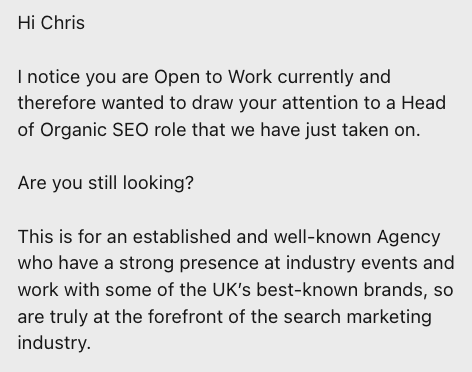

Sharing your expertise on these platforms is one of the easiest ways to increase your chances of getting a senior SEO role. Because, believe it or not, sometimes a job offer can be just a DM away.
Here’s some specific ideas of what you can share:
- Share your thoughts on a trending topic – like the latest Google algorithm update.
- Share what you learned during the course of a campaign.
- Ask the community for their thoughts on a certain topic.
I’ve recently started posting on LinkedIn and am impressed by the reach you can get by posting infrequently on these topics.
Here’s an example of one of my posts where I asked the community for help researching an article I was writing:
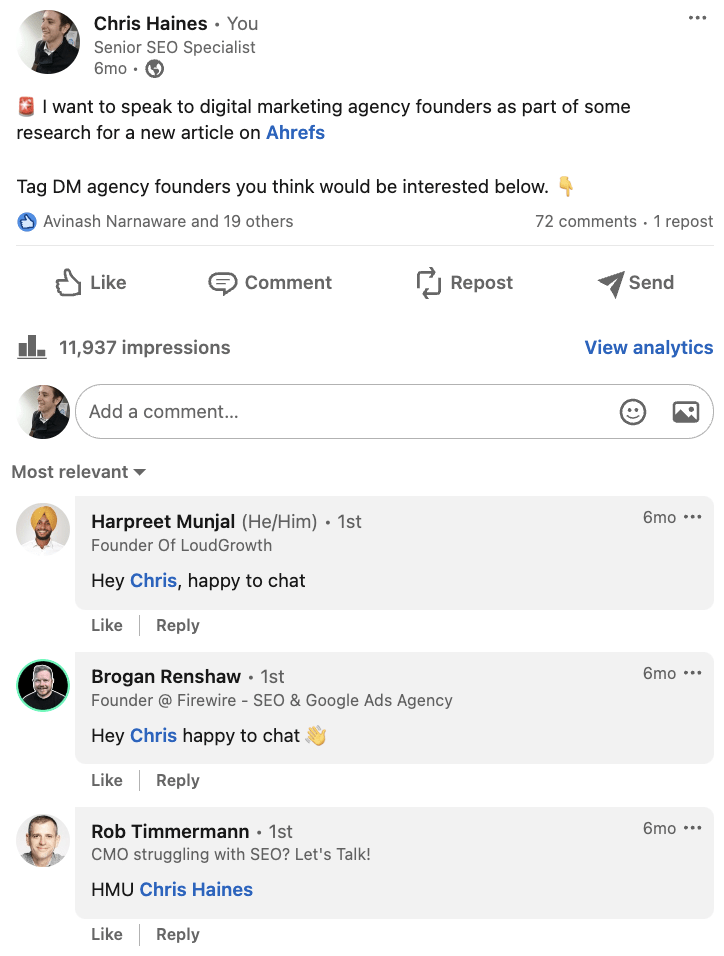

And here is the content performance across the last year from posting these updates.
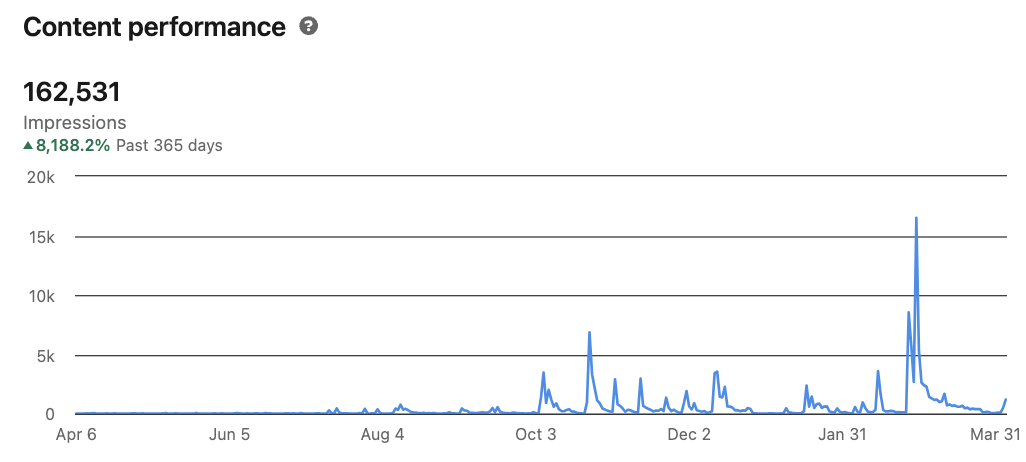

I’m clearly not a LinkedIn expert—far from it! But as you can see, with just a few months of posting, you can start to make these platforms work for you.
Godard Abel, co-founder of G2, talked on a podcast about conscious leadership. This struck a chord with me recently as I realized that I had practiced some of the principles of conscious leadership—unconsciously.
You can start practicing conscious leadership by asking yourself if your actions are above or below the line. Here are a few examples of above and below-the-line thinking:
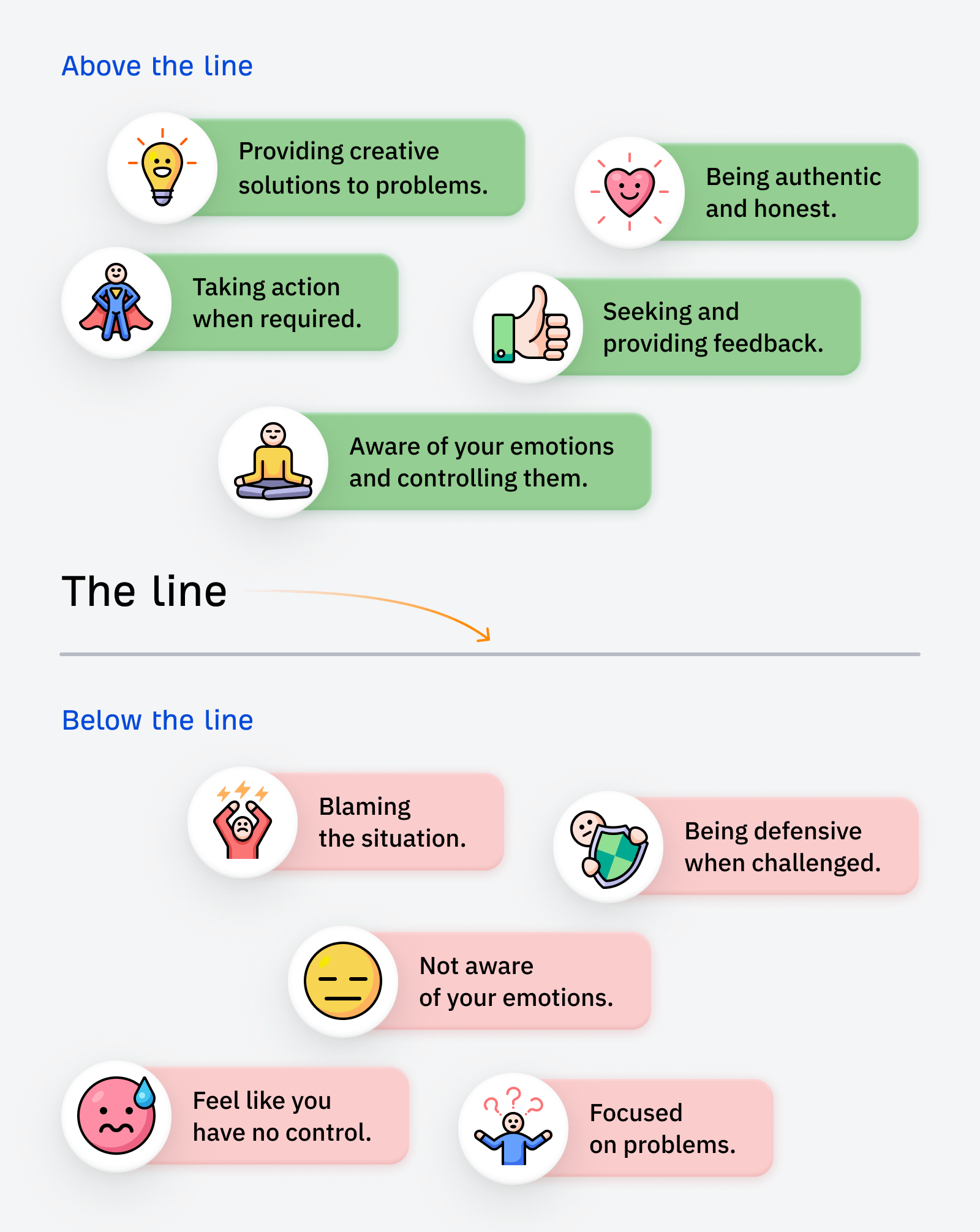

If you want a senior SEO role, I’d suggest shifting your mindset to above-the-line thinking.
In the world of SEO, it’s easy to blame all your search engine woes on Google. We’ve all been there. But a lot of the time, simple changes to your website can make a huge difference—it just takes a bit of effort to find them and make the changes.
SEO is not an exact science. Some stakeholders naturally get nervous if they sense you aren’t sure about what you’re saying. If you don’t get their support early on then you fall at the first hurdle.


To become more persuasive, try incorporating Aristotle’s three persuasive techniques into your conversations.
- Pathos: use logical reasoning, facts, and data to present water-tight arguments.
- Ethos: establish your credibility and ethics through results.
- Logos: make your reports tell a story.
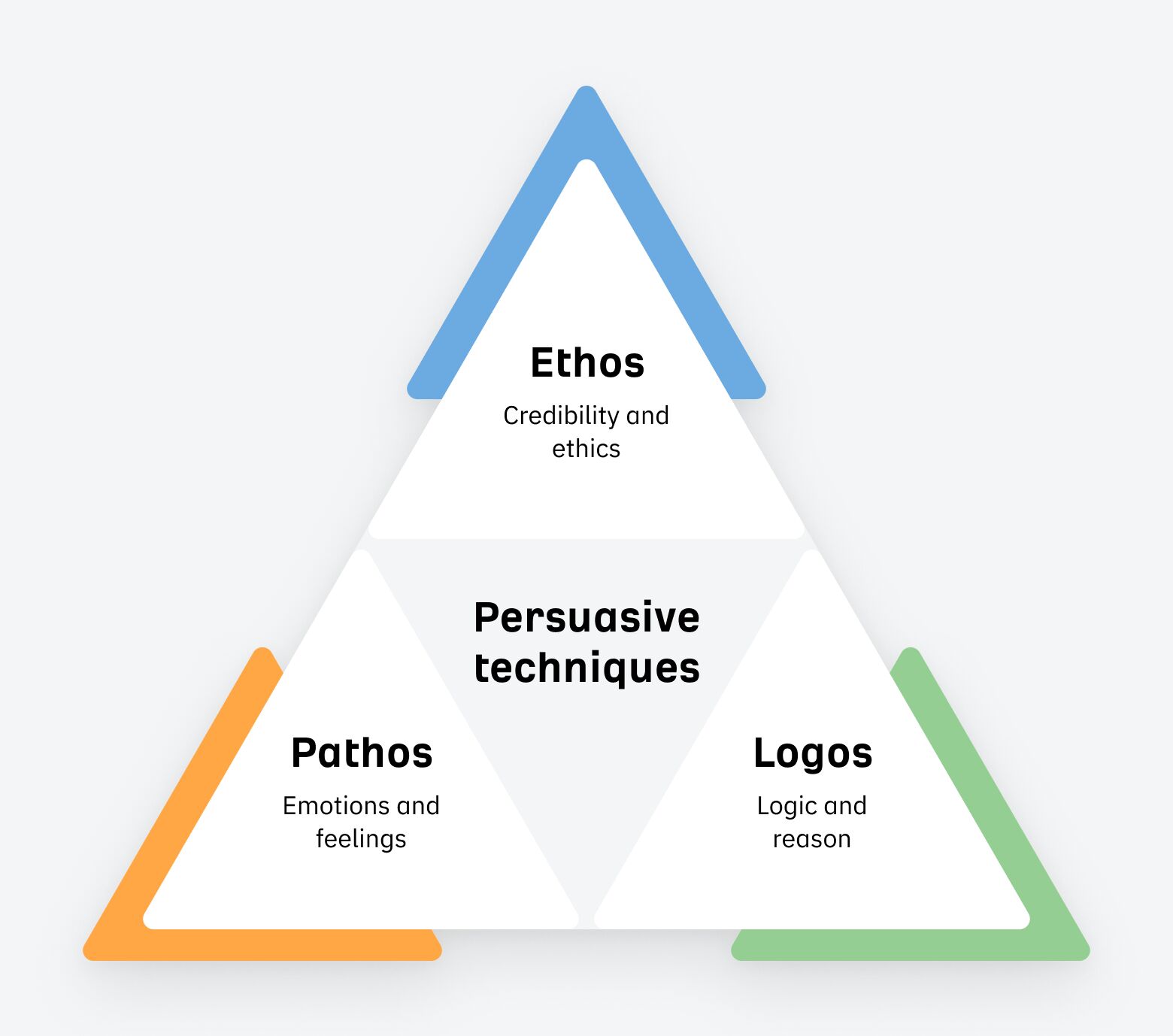

Then sprinkle in language that has a high level of modality:
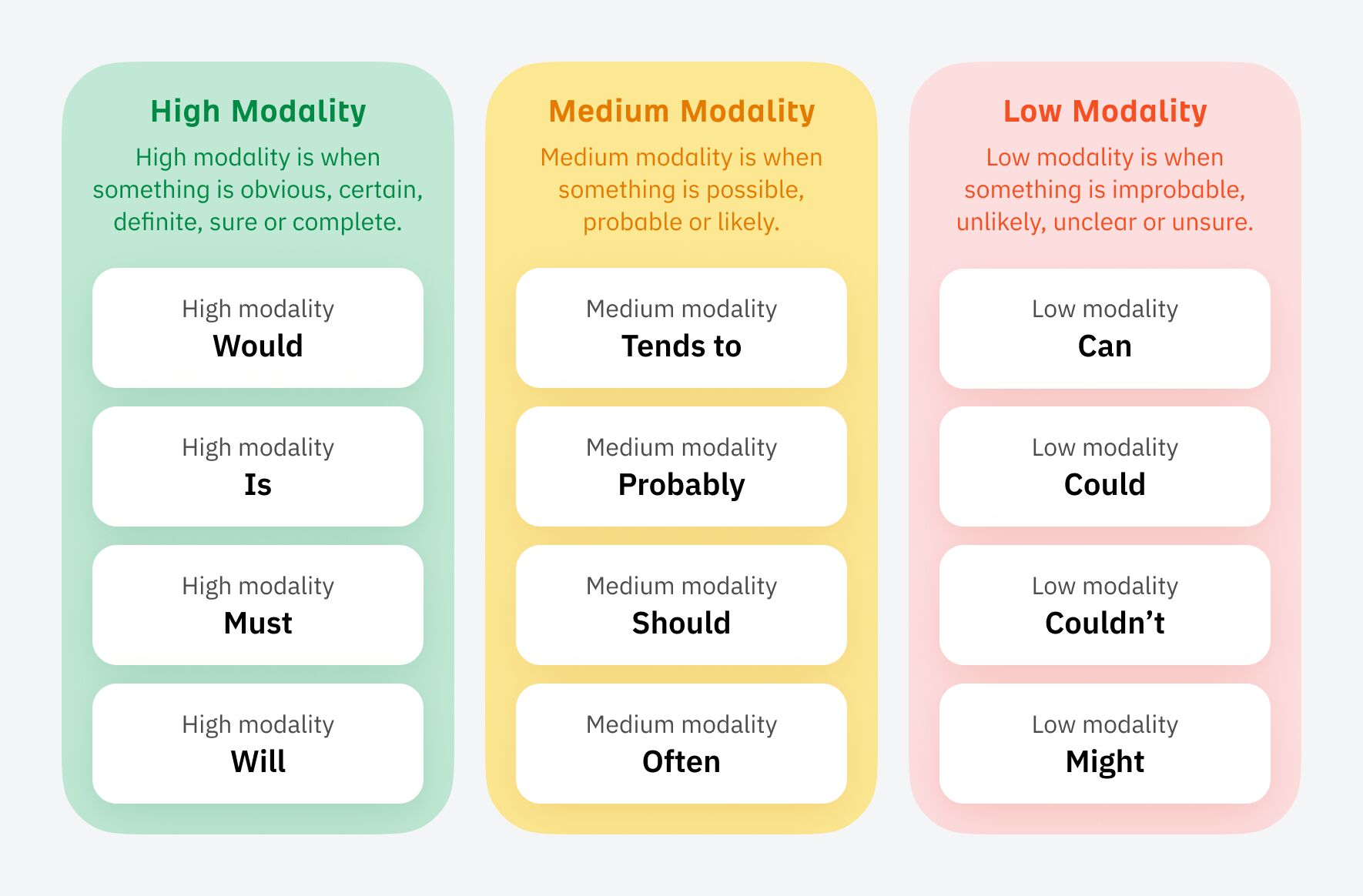

Some people will be able to do this naturally without even realizing it, but for others, it can be an uphill struggle. It wasn’t easy for me, and I had to learn to adapt the way I talked to stakeholders early on.
The strongest way I found was to appeal to emotions and back up with data from a platform like Ahrefs. Highlight what competitors have done in terms of SEO and the results they’ve earned from doing it.
Sidenote.
You don’t have to follow this tip to the letter, but being aware of these concepts means you’ll start to present more confident and persuasive arguments for justifying your SEO strategies.
When I started in SEO, I had zero connections. Getting a job felt like an impossible challenge.
Once I’d got my first SEO Lead job, it felt stupidly easy to get another one—just through connections I’d made along the way in my SEO journey.
I once got stuck on a delayed train with a senior member of staff, and he told me he was really into Google Local Guides, and he was on a certain high level. He said it took him a few years to get there.
Local Guides is part of Google Maps that allows you submit reviews and other user generated content
When he showed me the app, I realized that you could easily game the levels by uploading lots of photos.
In a “hold my beer” moment, I mass downloaded a bunch of photos, uploaded them to Local Guides and equaled his Local Guide level on the train in about half an hour. He was seething.
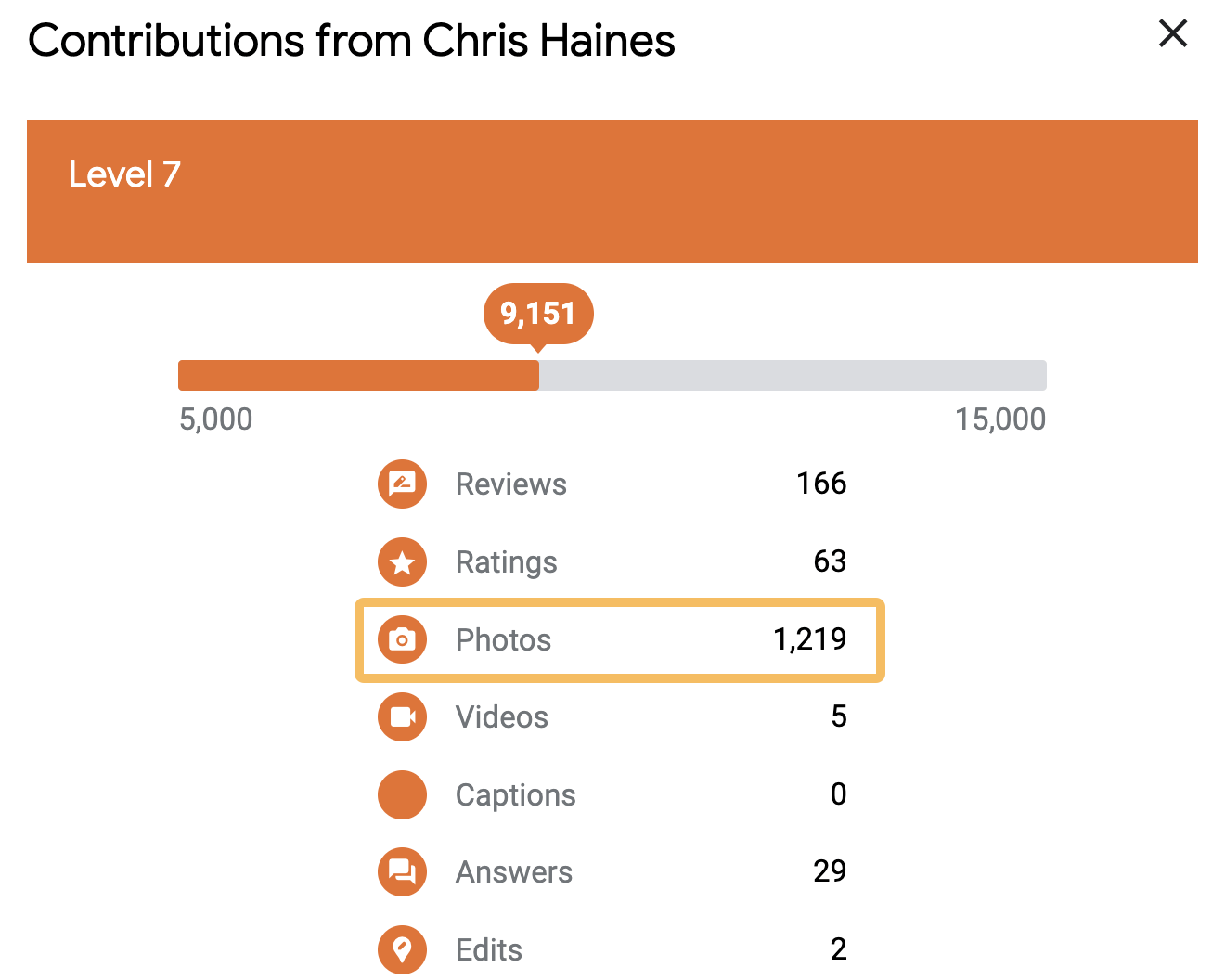

One of the photos I uploaded was a half-eaten Subway. It still amazes me that 50,974 people have seen this photo:
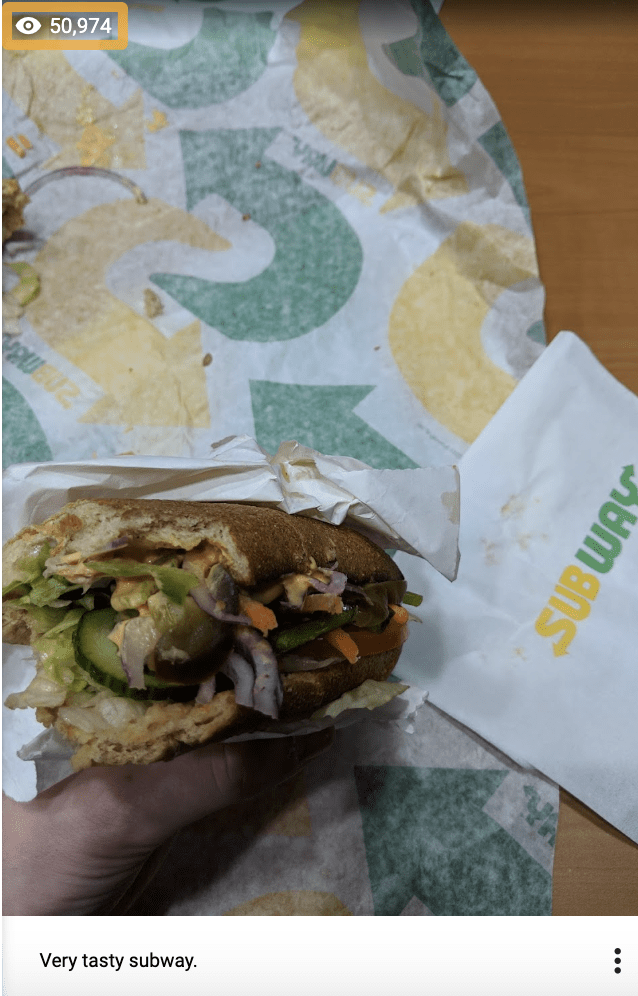

This wasn’t exactly SEO, but the ability to find this ‘hack’ so quickly impressed him, and we struck up a friendship.
The next month that person moved to another company, and then another few months later, he offered me an SEO Lead job.
Tip
Build connections with everyone you can—you never know who you might need to call on next.
Final thoughts
The road to becoming an SEO Lead seems straightforward enough when you start out, but it can quickly become long and winding.
But now armed with my tips, and a bucket load of determination, you should be able to navigate your way to an SEO Lead role much quicker than you think.
Lastly, if you want any more guidance, you can always ping me on LinkedIn. 🙂
SEO
7 Content Marketing Conferences to Attend in 2024
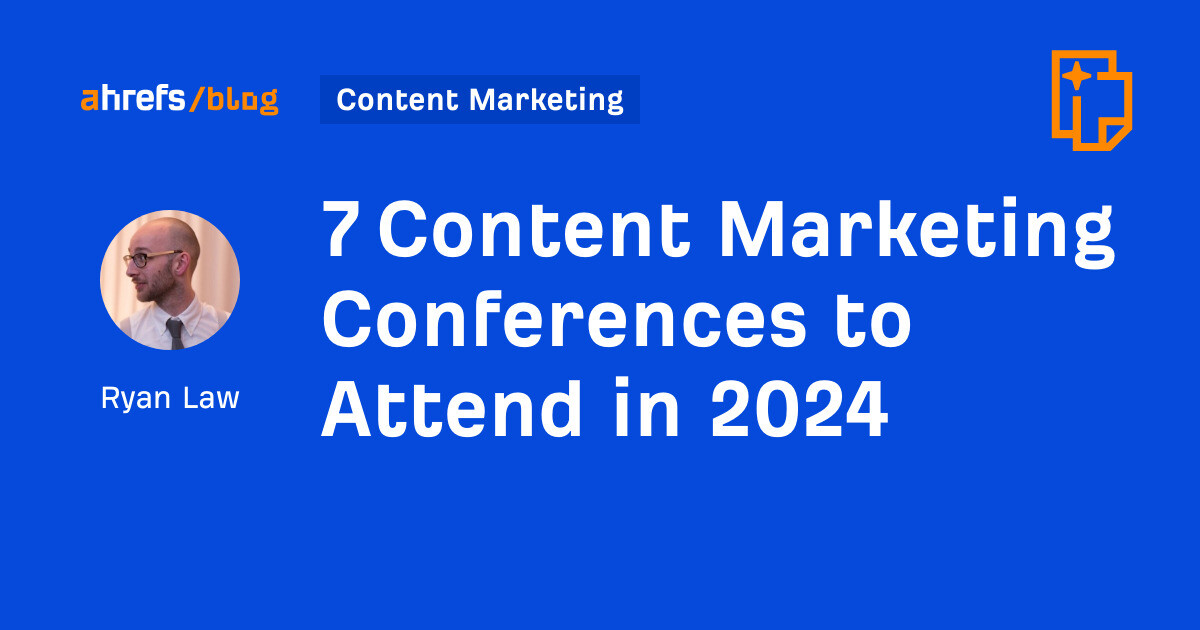
I spend most of my days sitting in front of a screen, buried in a Google Doc. (You probably do too.)
And while I enjoy deep work, a few times a year I get the urge to leave my desk and go socialize with other human beings—ideally on my employer’s dime 😉
Conferences are a great excuse to hang out with other content marketers, talk shop, learn some new tricks, and pretend that we’re all really excited about generative AI.
Without further ado, here are the biggest and best content marketing conferences happening throughout the rest of 2024.
Dates: May 5–7
Prices: from $795
Website: https://cex.events/
Location: Cleveland, OH
Speakers: B.J. Novak, Ann Handley, Alexis Grant, Justin Welsh, Mike King
CEX is designed with content entrepreneurs in mind (“contenpreneurs”? Did I just coin an awesome new word?)—people that care as much about the business of content as they do the craft.
In addition to veteran content marketers like Ann Handley and Joe Pulizi waxing lyrical about modern content strategy, you’ll find people like Justin Welsh and Alexis Grant exploring the practicalities of quitting your job and becoming a full-time content creator.
Here’s a trailer for last year’s event:
Sessions include titles like:
- Unlocking the Power of Book Publishing: From Content to Revenue
- Quitting A $200k Corporate Job to Become A Solo Content Entrepreneur
- Why You Should Prioritize Long-Form Content
(And yes—Ryan from The Office is giving the keynote.)
Dates: Jun 3–4
Location: Seattle, WA
Speakers: Wil Reyolds, Bernard Huang, Britney Muller, Lily Ray
Prices: from $1,699
Website: https://moz.com/mozcon
Software company Moz is best known in the SEO industry, but its conference is popular with marketers of all stripes. Amidst a lineup of 25 speakers there are plenty of content marketers speaking, like Andy Crestodina, Ross Simmonds, and Chima Mmeje.
Check out this teaser from last year’s event:
This year’s talks include topics like:
- Trust and Quality in the New Era of Content Discovery
- The Power of Emotion: How To Create Content That (Actually) Converts
- “E” for Engaging: Why The Future of SEO Content Needs To Be Engaging
Dates: Sep 18–20
Location: Boston, MA
Speakers: TBC
Prices: from $1,199
Website: https://www.inbound.com/
Hosted by content marketing OG HubSpot, INBOUND offers hundreds of talks, deep dives, fireside chats, and meetups on topics ranging from brand strategy to AI.
Here’s the recap video:
I’ve attended my fair share of INBOUNDs over the years (and even had a beer with co-founder Dharmesh Shah), and always enjoy the sheer choice of events on offer.
Keynotes are a highlight, and this year’s headline speaker has a tough act to follow: Barack Obama closed out the conference last year.
Dates: Oct 22–23
Location: San Diego, CA
Speakers: TBC
Prices: from $1,199
Website: https://www.contentmarketingworld.com/
Arguably the content marketing conference, Content Marketing World has been pumping out content talks and inspiration for fourteen years solid.
Here’s last year’s recap:
The 2024 agenda is in the works, but last year’s conference explored every conceivable aspect of content marketing, from B2C brand building through to the quirks of content for government organizations, with session titles like:
- Government Masterclass: A Content Marketing Strategy to Build Public Trust
- A Beloved Brand: Evolving Zillow’s Creative Content Strategy
- Evidence-Based SEO Strategies: Busting “SEO Best Practices” and Other Marketing Myths
Dates: Oct 24–25
Location: Singapore
Speakers: Andy Chadwick, Nik Ranger, Charlotte Ang, Marcus Ho, Victor Karpenko, Amanda King, James Norquay, Sam Oh, Patrick Stox, Tim Soulo (and me!)
Prices: TBC
Website: https://ahrefs.com/events/evolve2024-singapore
That’s right—Ahrefs is hosting a conference! Join 500 digital marketers for a 2-day gathering in Singapore.
We have 20 top speakers from around the world, expert-led workshops on everything from technical SEO to content strategy, and tons of opportunities to rub shoulders with content pros, big brands, and the entire Ahrefs crew.
I visited Singapore for the first time last year and it is really worth the trip—I recommend visiting the Supertree Grove, eating at the hawker markets in Chinatown, and hitting the beach at Sentosa.
If you need persuading, here’s SEO pro JH Scherck on the Ahrefs podcast making the case for conference travel:
And to top things off, here’s a quick walkthrough of the conference venue:
Dates: Oct 27–30
Location: Portland, OR
Speakers: Relly Annett-Baker, Fawn Damitio, Scott Abel, Jennifer Lee
Prices: from $1,850
Website: https://lavacon.org/
LavaCon is a content conference with a very technical focus, with over 70 sessions dedicated to helping companies solve “content-related business problems, increase revenue, and decrease production costs”.
In practice, that means speakers from NIKE, Google, Meta, Cisco, and Verizon, and topics like:
- Operationalizing Generative AI,
- Taxonomies in the Age of AI: Are they still Relevant?, and
- Out of Many, One: Building a Semantic Layer to Tear Down Silos
Here’s the recap video for last year’s conference:
Dates: Nov 8
Location: London
Speakers: Nick Parker, Tasmin Lofthouse, Dan Nelken, Taja Myer
Prices: from £454.80
Website: https://www.copywritingconference.com/
CopyCon is a single-day conference in London, hosted by ProCopywriters (a membership community for copywriters—I was a member once, many years ago).
Intended for copywriters, creatives, and content strategists, the agenda focuses heavily on the qualitative aspects of content that often go overlooked—creative processes, tone of voice, and creating emotional connections through copy.
It’s a few years old, but this teaser video shares a sense of the topics on offer:
This year’s talks include sessions like:
- The Mind-Blowing Magic of Tone of Voice,
- The Power of AI Tools as a Content Designer, and the beautifully titled
- Your Inner Critic is a Ding-Dong.
(Because yes, your inner critic really is a ding-dong.)
Final thoughts
These are all content-specific conferences, but there are a ton of content-adjacent events happening throughout the year. Honourable mentions go to DigiMarCon UK 2024 (Aug 29–30, London, UK), Web Summit (Nov 11–14, Lisbon, Portugal), and B2B Forum (Nov 12–14, Boston, MA).
I’ve focused this list solely on in-person events, but there are also online-only conferences available, like ContentTECH Summit (May 15–16).
Heading to a content conference that I haven’t covered? Share your recommendation with me on LinkedIn or X.
-

 PPC4 days ago
PPC4 days ago19 Best SEO Tools in 2024 (For Every Use Case)
-

 PPC7 days ago
PPC7 days ago4 New Google Ads Performance Max Updates: What You Need to Know
-

 MARKETING6 days ago
MARKETING6 days agoWill Google Buy HubSpot? | Content Marketing Institute
-
SEARCHENGINES6 days ago
Daily Search Forum Recap: April 16, 2024
-

 SEO6 days ago
SEO6 days agoGoogle Clarifies Vacation Rental Structured Data
-

 MARKETING6 days ago
MARKETING6 days agoStreamlining Processes for Increased Efficiency and Results
-
SEARCHENGINES5 days ago
Daily Search Forum Recap: April 17, 2024
-

 PPC7 days ago
PPC7 days agoHow to Collect & Use Customer Data the Right (& Ethical) Way















